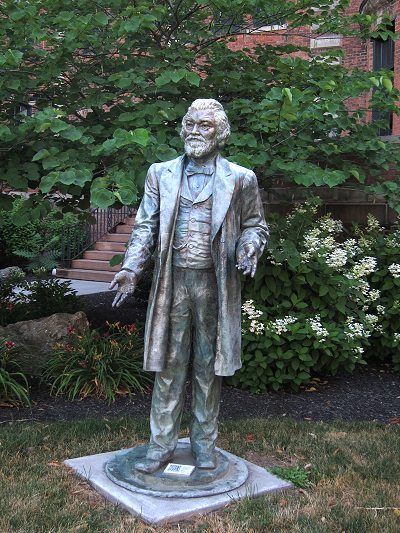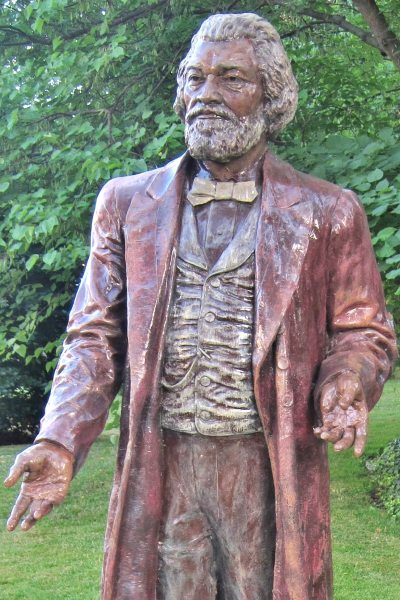Index
Frederick Douglass in Rochester
This write-up was done for the bicentennial of Frederick Douglass' birth in 2018. It is an attempt to bring Rochester history, too often neglected, into the story. Deeds for his Alexander Street and South Avenue properties are included as is information on his Civil War income tax. Extensive use was made of the Rochester newspaper archive in the Local History & Genealogy Division of the Rochester Public Library. Copies of original articles are included to present period information. Rochester had several newspapers during Douglass' time in the city so one may want to examine the archive for alternate views. Biographies by Philip Foner and William Mc Feely and the three Douglass' autobiographies, Narrative of the Life of Frederick Douglass, An American Slave. Written by Himself (1845), My Bondage and My Freedom (1855) and Life and Times of Frederick Douglass (1881) were key resources. An expanded version of Life and Times was issued in 1892. Page references refer to Douglass Autobiographies, Library of America, ISBN 1-883011-30-2 which contains all three autobiographies and a Douglass chronology in one volume.
The piece starts with a short section bringing Douglass from Maryland to Rochester.
The web site, Ordinary Philosophy, has an excellent tour of Douglass sites in Rochester.
Escape from Slavery
The year 2018 will be the 180th anniversary of Douglass' escape from slavery. He did not reveal his method of escape until his third autobiography, Life and Times. On Monday, September 3,1838 and aided by a free black woman, Anna Murray, Frederick Washington Augustus Bailey, dressed as a sailor and carrying a sailor's protection, escaped slavery, travelling from Baltimore to New York. Knowing no one in New York City he felt lonely and insecure. "I was in the midst of an ocean of my fellow-men, and yet a perfect stranger to every one. I was without home, without acquaintance, without money, without credit, without work, and without any definite knowledge as to what course to take or where to look for succor." (Life and Times, p649) After spending a night on the docks, he met a sailor who took him to his home for the night and the next day introduced him to David Ruggles, the organizer of the New York Committee of Vigilance.
Frederick stayed with Ruggles while planning a move to New Bedford, Massachusetts. Anna Murray came to New York and Anna and Frederick were married on September 15, 1838. The marriage certificate shows the surname Johnson. This is explained by a passage from My Bondage and My Freedom, p 354.
The name given to me by my beloved mother was no less pretentious than "Frederick Augustus Washington Bailey." I had, however, before leaving Maryland, dispensed with the Augustus Washington, and retained the name Frederick Bailey. Between Baltimore and New Bedford, however, I had several different names, the better to avoid being overhauled by the hunters which I had good reason to believe would be on my track. Among honest men an honest man may well be content with one name, and to acknowledge it at all times and in all places; but toward fugitives, Americans are not honest. When I arrived in New Bedford, my name was Johnson: and finding the Johnson family in New Bedford were already quite numerous -- sufficiently so to produce some confusion in attempts to distinguish one from another-- there was more reason for making another change in my name. In fact, "Johnson" had been assumed by nearly every slave who had arrived in New Bedford from Maryland, and this, much to the annoyance of the original 'Johnsons' (of whom there were many) in that place. Mine host, unwilling to have another of his own name added to the community in this unauthorized way, after I spent a night and a day at his house, gave me my present name. He had been reading the "Lady of the Lake," and was pleased to regard me as a suitable person to wear this, one of Scotland's many famous names.
The name from the Lady of the Lake has one 's' but Frederick chose to use two. It has been speculated he knew of a Douglass Street in Baltimore or a family that used that spelling.
Arriving in New Bedford on September 18, 1838 Douglass began the life of a common laborer, shoveling coal, loading a sloop and sawing wood. He was impressed with life in the North but things weren't perfect. He was hired as a ships caulker, a trade he had learned in Baltimore, but was let go because the white men wouldn't work with him. He then worked in a whale oil plant and a brass foundry. He became acquainted with the Liberator, an abolitionist newspaper, and attended several lectures by abolitionists. Planning on joining the Elm Street Methodist Church he found blacks were required to sit in a separate section, receive communion after the whites and decided to join the Zion Methodist Church. It is here he had his first contact with Rochester, when the Reverend Thomas James was sent to New Bedford.
An escaped slave, from eastern New York, settled in Rochester, worked in a warehouse on the Erie Canal, learned to read and write, joined the African Methodist Episcopal Society in 1823 and began to prepare for the ministry.
I was ordained as a minister in May 1833, by Bishop Rush. I had been called Tom as a slave and Jim at the warehouse. I put both together when I reached manhood and was ordained as Rev. Thomas James.
After serving in Syracuse, Ithaca and several other places, in 1840 he was sent to New Bedford.
It was at New Bedford that I first saw Fred. Douglass. He was then, so to speak, right out of slavery, but had already begun to talk in public, though not before white people. He has been given authority to act as an exhorter by the church before my coming, and I some time afterwards licensed him to preach. He was then a member of my church. On one occasion, after I had addressed a white audience on the slavery question, I called upon Fred. Douglass, who I saw among the auditors, to relate his story. He did so, and in a year from that time he was in the lecture field with Parker Pillsbury and other leading abolitionist orators.
The above quotes are from the Life of Rev. Thomas James, By Himself. A summary is available. He is buried in Mount Hope Cemetery at N 43° 07.488" W 077° 37.189".
Abolitionist Orator
Frederick began speaking to mixed audiences, became aware of the abolitionist movement, attended abolitionist lectures and was a reader of the Liberator, the publication of the American Anti-Slavery Society. In the summer of 1841 he attended an abolitionist convention on Nantucket where he was recognized and asked to speak by William Coffin, a prominent abolitionist, who heard him speak in New Bedford. Frederick's topic was his experiences as a slave. He was followed by William Lloyd Garrison who used Frederick's words as the basis for his speech. After the meeting he was offered a job as an agent by the Massachusetts Anti-Slavery Society. In his own words, from Life and Times, page 661:
I was reluctant to take the proffered position. I had not been quite three years from slavery and was honestly distrustful of my ability, and wished to be excused. Besides, publicity might discover me to my master, and many other objections presented themselves. But Mr. Collins was not to be refused, and I finally consented to go out for three months, supposing I should in that length of time some to the end of my story and my consequent usefulness.
Here opened for me a new life---a life for which I had no preparation. Mr. Collins used to say when introducing me to an audience, I was a "graduate from the peculiar institution, with my diploma written on my back".
Agents traveled in groups of two or three lecturing and getting subscriptions to the Anti-Slavery Standard and the Liberator. Frederick, as an escaped slave, was a curiosity and people turned out to see him. Frederick was expected to tell his experiences as a slave and as he had underestimated himself a few months earlier his abolitionist friends underestimated him now, not seeing beyond the role they had assigned him. From Life and Times, pgs 662 - 663:
During the first three of four months my speeches were almost exclusively made up of narrations of my own personal experience as a slave. "Let us have the facts," said the people. So also said friend George Foster, who always wished to pin me down to a simple narrative. "Give us the facts," said Collins, "we will take care of the philosophy." Just here arose some embarrassment. It was impossible for me to repeat the same old story month after month and keep up my interest in it. It was new to the people, it is true, but it was an old story to me; and to go through with it night after night was a task altogether too mechanical for my nature. "Tell your story, Frederick," would whisper my revered friend, Mr. Garrison, as I stepped upon the platform. I could not always follow the injunction, for I was now reading and thinking. New views of the subject were being presented to my mind. It did not entirely satisfy me to narrate wrongs: I felt like denouncing them. I could not always curb my moral indignation for the perpetrators of slave-holding long enough for a circumstantial statement of the facts which I felt almost sure everybody must know. Besides I was growing and needed room.
People won't believe you were ever a slave Frederick, if you keep on this way," said friend Foster. "Be yourself," said Collins, "and tell your story." "Better have a little of the plantation speech than not," was said to me; "it is not best that you seem too learned." These excellent friends were actuated by the best of motives and were not altogether wrong in their advice; and still I must speak just the word that seemed to me the word to be spoken by me.
Douglass' first physical contact with Rochester would happen during this period.
Worldhistoryproject.org states, In 1843 Douglass participated in the Hundred Conventions project, the American Anti-Slavery Society's six month tour of meeting halls throughout the west.
Chapter V of Life and Times is titled "One Hundred Conventions." Douglass made his first visit to Rochester when he attended the Western New York Anti-Slavery Society's Convention held August 3, 4 and 5, 1843. The Convention was held in the Bethel Church on Joiner Street. Joiner Street was one street east of and ran parallel to Clinton Avenue. He attended the National Convention of Colored Men August 15 - 19 in Buffalo.
As he grew up, Frederick spent time on his own imitating people, so he would speak "properly". As a speaker he was so good many believed he was never a slave. To change that impression he wrote an autobiography giving just enough information to prove his story was truthful. He spent the winter and spring of 1844-45 writing his book which was titled, Narrative of the Life of Frederick Douglass an American Slave - Written By Himself. The book was published in the middle of 1845 and sold 4,500 copies by the fall. Several European editions were printed and within five years 30,000 copies had been sold. In 2017, The Guardian listed the "Narrative" number sixty-eight in a list of the 100 Best Non-Fiction Books of All Time.
In Great Britain
Douglass had published a book which revealed his new name and enough information that he could be identified. It was decided to avoid potential capture, he would spend time in Britain and become acquainted with British abolitionists and enlist their help in the American cause. In My Bondage and My Freedom, Chapter XXIV is titled Twenty One Months in Great Britain. Frederick says little about his family life in the three autobiographies but one wonders how he could leave Anna at home with four children; Rosetta born June 24, 1838; Lewis Henry October 9, 1840; Frederick Jr. March 3, 1842 and Charles Remond October 21, 1844. It was a different time and Anna always supported Frederick's anti-slavery activities. Two recent books, Frederick and Anna Douglass in Rochester, New York, O'Keefe, 2014 and Women In The World Of Frederick Douglass, Fought, 2017, give insights into the Douglass' home life.
Arranging for Anna to receive the proceeds from the sales of the "Narrative" and be looked after by abolitionist friends, Frederick sailed for Ireland on August 16, 1845, accompanied by another abolitionist from Lynn, Massachusetts. Frederick who had chaffed under the oversight of New England abolitionists would now be free to speak his mind. He would experience new cultures, new ideas, new ways of thinking and gain many new supporters.
Douglass first visited Ireland, then Scotland and finally England. He found all three to be free of racial prejudice but also saw areas that needed improvement. On his return to the United States his agenda had expanded beyond abolitionism to human rights and he seemed to accept a more militant approach.
Two significant events occurred during his stay in Britain. The first, in late 1846, a group of his English friends bought his freedom from Thomas Auld. This would allow him to return to the United States and continue his work free of the threat of slave catchers. On December 12, 1846 his manumission papers were registered in the Baltimore County courthouse. Some people accused Douglass of recognizing the "right to traffic in human beings" and others said as a free man he lost the "moral authority" to speak for slaves.
The following is a link to documents related to purchasing Douglass' freedom.
https://www.gilderlehrman.org/sites/default/files/inline-pdfs/07484_FPS.pdf
The second major event occurred at Douglass' departure party. He tells of it in his own words beginning on page 386 of My Bondage And My Freedom. A condensed version follows.
Having continued in Great Britain and Ireland nearly two years, and being about to return to America - not as I left it, a slave, but as a freeman - leading friends of the cause of emancipation in that country intimated their intention to make me a testimonial, not only on grounds of personal regard to myself, but also to the cause to which they were so ardently devoted. How far any such thing could have succeeded, I do not know; but many reasons led me to prefer that my friends should simply give me the means of obtaining a printing press and printing materials, to enable me to start a paper, devoted to the interests of my enslaved and oppressed people. ---- I further stated that, in my judgment, a tolerably well conducted press, in the hands of the despised race, by calling out the mental energies of the race itself; by making them acquainted with their own latent powers; by enkindling among them the hope that for them there is a future; by developing their moral power; by refining and reflecting their talents - would prove a most powerful means of removing prejudice, and of awakening an interest in them. ---- These views I laid before my friends. The result was, nearly two thousand five hundred dollars were speedily raised toward starting my paper.
In My Bondage and My Freedom, p 389 - 390 Douglass writes,
Intimation had reached my friends in Boston of what I intended to do, before my arrival, and I was prepared to find them favorably disposed towards my much cherished enterprise. In this I was mistaken. I found them very earnestly opposed to the idea of my starting a paper, and for several reasons. First, the paper was not needed; secondly, it would interfere with my usefulness as a lecturer; thirdly, I was better fitted to speak than to write; fourthly, the paper could not succeed. This opposition from a quarter so highly esteemed, and to which I had been accustomed to look for advice and direction, caused me not only to hesitate, but inclined me to abandon the enterprise.
Considering that Douglass believed starting a paper was so important, "My much cherished enterprise" and had accepted money from English abolitionists for that purpose it's hard to believe he put this goal aside so easily. The Liberator of June 25, 1847 page 2 column 6 contains several references to Douglass abandoning his newspaper project. The July 9, 1847 issue has several replies, one by Douglass himself.
Back in the U.S.
With the newspaper issue apparently settled, Garrison and Douglass agreed to attend the meeting of the Western Anti-Slavery Society in New Lyme, Ohio. This meeting would be preceded by an August speaking tour from Philadelphia to Pittsburgh with many stops along the way and often multiple stops each day. Douglass encountered the usual difficulties of travelling, eating and staying in the same places as his white colleagues. In many places, churches and other venues would not allow their facilities to be used for meetings. In Harrisburg, Garrison spoke but when Douglass rose he was pelted with rotten eggs. The trip was exhausting and giving so many speeches, at times Douglass needed to rest his voice. The trip had limited success. (An Antislavery Journey: Garrison and Douglass in Pennsylvania, 1847, Ira V. Brown, The Pennsylvania State University)
To read about the tour in Douglass' words read his letters to Sydney H. Gay in McKivigan, The Frederick Douglass Papers: Series Three: Correspondence, Volume 1: 1842 - 1852.
In contrast, the Western Anti-Slavery Society meeting was very well attended and Garrison was elated. Later after arriving in Cleveland, Garrison had a physical breakdown and stayed there under a doctor's care for six weeks. At Garrisons urging, Douglass continued on alone and would stop in Buffalo, Rochester and Syracuse among other places. The Rochester meeting was an Anti-Slavery Convention held at the Court House on September 16th and 17th. The Court House was the first Monroe County Courthouse, which was in use from 1822 to 1850. There is a photograph of the Court House, but it turns out to be a photograph of a building, built for the 1934 Centennial Celebration.
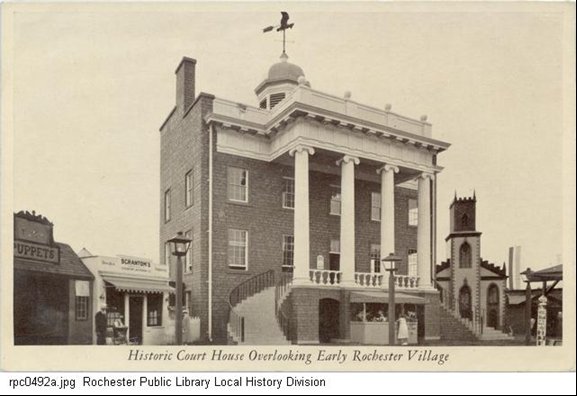
A picture of the Courthouse sketched by an English traveler, Basil Hall, in 1827 exists. The following is a hand colored version.
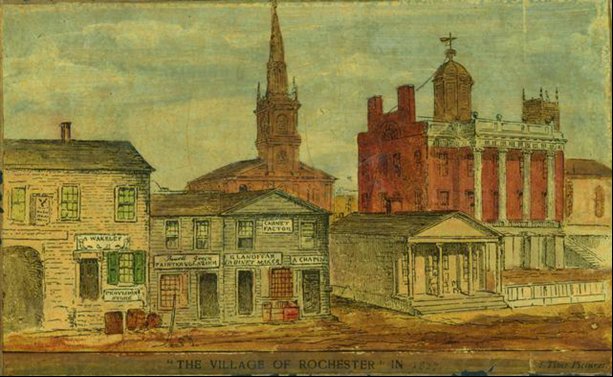
Rochester Public Library Local History Division
The Court House (1822) is in the right center. The large church in the center rear is First Presbyterian (1824) and the church whose steeple is at the upper right of the courthouse is St. Luke's Episcopal.(1825).
Douglass described the Rochester meetings in a letter to Sydney H. Gay on 26 September 1847.
The meetings at Rochester were all that we could desire. They continued two days, and were interesting and spirit-stirring to the last. I have seldom seen more intellectual looking persons than those who attended our afternoon and evening meetings in that place. The papers of that city are expressing much regret that so many respectable persons attended, and encourages the fanatical and treasonable designs of the speakers on that occasion. I presume that respectable people may be safely left to decide for themselves the character and quality of the meetings they will encourage by their presence, without advice or direction from a priest who will defend man-stealing under any circumstances.
The Rochester Daily Democrat for September 21, 1847 lists the resolution passed at the anti-Slavery Convention.
Mister Editor
At the time, meetings opened by the assembled electing a Chairman to run the proceedings. In this case the Chairman was Henry Bush. In a letter from Henry Bush to Douglass found in McKivigan a footnote states, "Best remembered as the husband of early women's rights leader Abigail Norton Bush, Henry Bush (1805 - ?) was a Rochester stove manufacturer. Abigail Bush chaired the Rochester Women's Rights Convention of 1848, becoming the first woman to preside over a women's rights convention, and held the president's office of the Western New York Anti-Slavery Society in 1849. In 1850 Henry Bush left his wife and five children in Rochester to search for gold in California. Two years later the family reunited in the West.
Douglass left Rochester to continue his tour. The next mention of Douglass of interest to us appeared in the Liberator of October 1, 1847 under the title Frederick Douglass's Paper. The article is on page 2, column 6.
We see it stated, positively, in the Cleveland 'True Democrat' that 'Frederick Douglass has determined upon starting a new paper, and to make this City his head-quarters. It is to be called the NORTH STAR, and is to be devoted wholly to the subject of human rights'. This statement being ???? positive and circumstantial, we cannot doubt its correctness.
A prospectus, again mentioning Cleveland, appears in the October 15, 1847 Liberator.

From Niles National Registry October 16, 1847

An October 28, 1847 letter from Frederick Douglass to Amy Post in the Rare Books and Special Collections Department of the University of Rochester Libraries indicates a change of plans.
The slights that Douglass felt during his trip through Pennsylvania apparently rekindled his desire to be an editor but why Cleveland and why the switch to Rochester? The reasons are not known.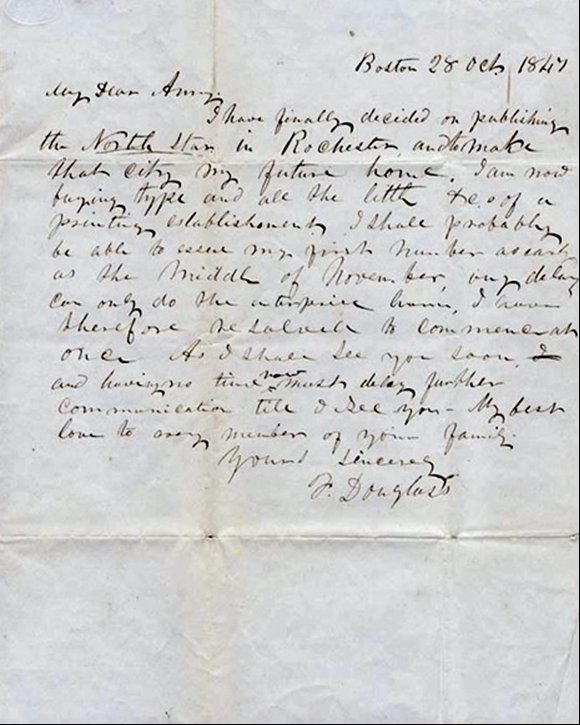
Rare Books and Special Collections - University of Rochester
A prospectus mentioning Rochester soon appeared.
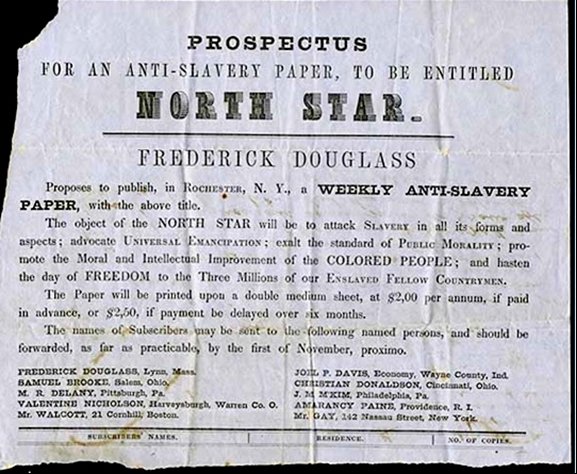
Rare Books and Special Collections - University of Rochester
Newspaper Office
We know that Douglass would move to Rochester, establish the North Star office in the Talman Building and buy a house at 4 Alexander Street. Information is available but exactly how things transpired is not known. Since he moved into the Talman Building before buying a house we'll start there.
Douglass had visited Rochester at least twice before the September, 1847 Anti-Slavery Convention. Once in 1843, at a meeting in Bethel Church and on July 23,1845 when he lectured in Talman Hall. Talman Hall was on the top floor of the Talman Building so Douglass was familiar with the building and would have made connections with local abolitionists during this visit. It is likely during this trip he learned an Anti-Slavery Society was formed in Rochester in 1835, heard of Myron Holley and that two Anti-Slavery newspapers had been printed in Rochester.
In 1803 three men from Hagerstown, Maryland purchased Ebenezer Allen's "100 acre plot". The men were Nathaniel Rochester, Charles Carroll and William Fitzhugh. William Fitzhugh's daughter Mary married John Talman and in 1822 his daughter Ann married the well known abolitionist Gerrit Smith. Smith and Douglass should have been aware of each other. In 1839, when William Fitzhugh died, his daughter Mary inherited the parcel which became known as the Talman Building. It is possible that the 1845 Douglass lecture and the locating the North Star office in the Talman Building occurred because of the Smith-Talman family connection. Note that Douglass worried about finding a house in Rochester but does not mention looking for a location for the North Star office. Could that have been decided, possibly by contact with Gerrit Smith, before writing Amy Post?
A look at the advertisements in the 1847 City Directory indicates the Talman Building had become a center for publishing. Some of the ads are:

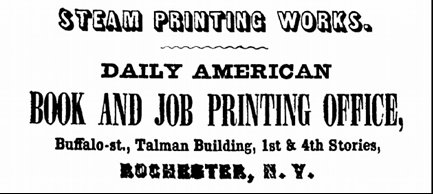


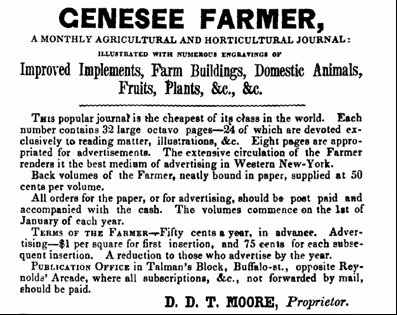
The Advent Harbinger was also published by Joseph Marsh from an office in the Talman Building.
From Lynn to 4 Alexander
From McFeely page 153 , "Douglass boarded with Charles Joiner while he was getting the paper started". Under "Colored Persons", the 1847 Rochester city directory lists, Joiner, Charles, Clothes Cleaner, h. 48 Atwater. From 1838 to 1851 Rochester city directories had a separate section for "Colored Persons". Atwater no longer exists but ran east from the river along what is now the south side of the Inner Loop. Joiners house would have been east of today's Clinton Avenue.
The North Star of February 11, 1848 mentions Douglass is "in the middle of removing" his family to Rochester. Anna was not happy with the move having put down roots in Lynn, Massachusetts while Frederick was in Great Britain.
Three letters in McKivigan, The Frederick Douglass Papers Series Three: Correspondence, Volume: 1 1842 - 1852 Yale University Press give information on the physical move from Lynn to Rochester.
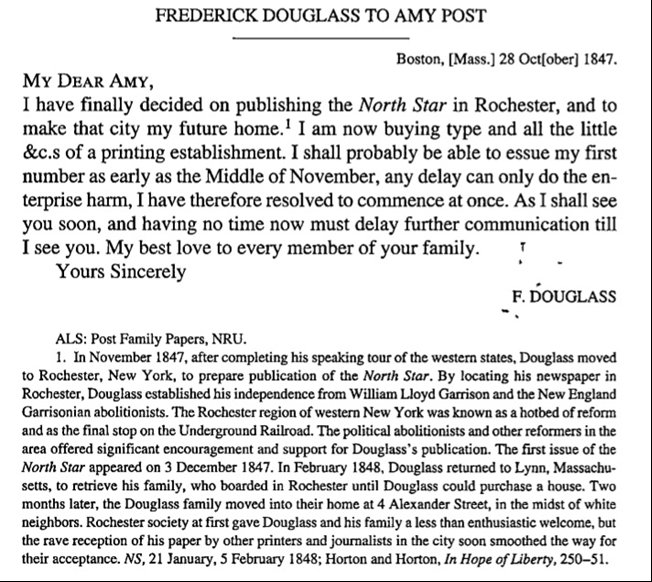
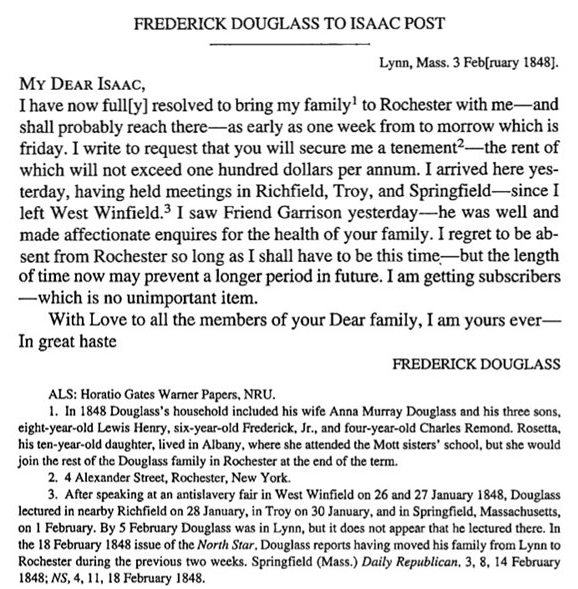
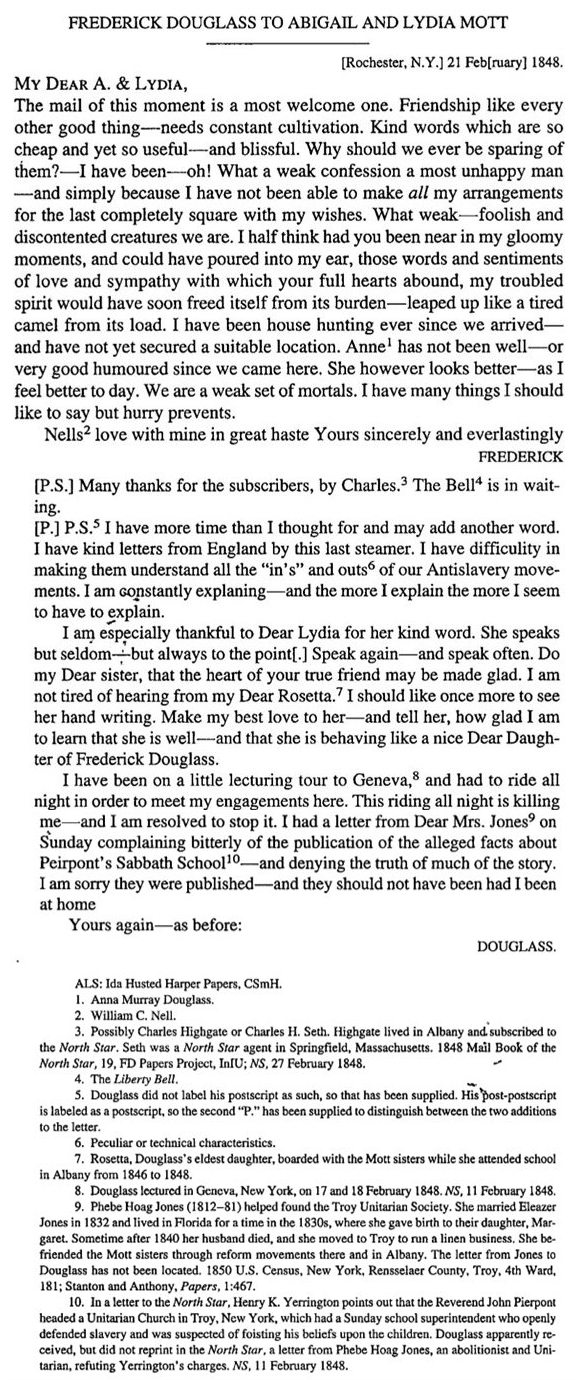
Douglass had many irons in the fire. He was moving his family to Rochester and having difficulty finding a house. He asked Isaac Post to find him a house he could rent for less the 100 dollars per year. He was setting up his printing press and other equipment, writing for and editing the North Star and lecturing to make money and get subscribers for his paper. And yes he did ride horses. With all this going on, in a little more than a month he was able to publish the first issue of the North Star on December 3, 1847.
- http://docsouth.unc.edu/neh/douglass/support15.html
- http://chnm.gmu.edu/loudountah/resources_files/byrne_douglass.pdf
Regarding 4 Alexander Street, Joseph Marsh is of interest because Douglass located the North Star office in the Talman Building, where Marsh published the Advent Harbinger, and he also became Marsh's next door neighbor. Marsh lived at 2 Alexander Street. The 1847 City Directory lists; Marsh, Joseph, Elder, Editor and Proprietor Advent Harbinger, 3rd story, Talman Block, Buffalo, h 8 Summit. The 1849 Directory lists Marsh, Joseph, Editor Advent Harbinger. No home address is listed. In 1851 the listing is Marsh, Joseph, editor Advent Harbinger, Talman Block, h 2 Alex'r. City Directories were issued every other year so gaps exist.
The following two pictures are from an 1851 map. Note that what is now East Avenue was Main Street in 1851.
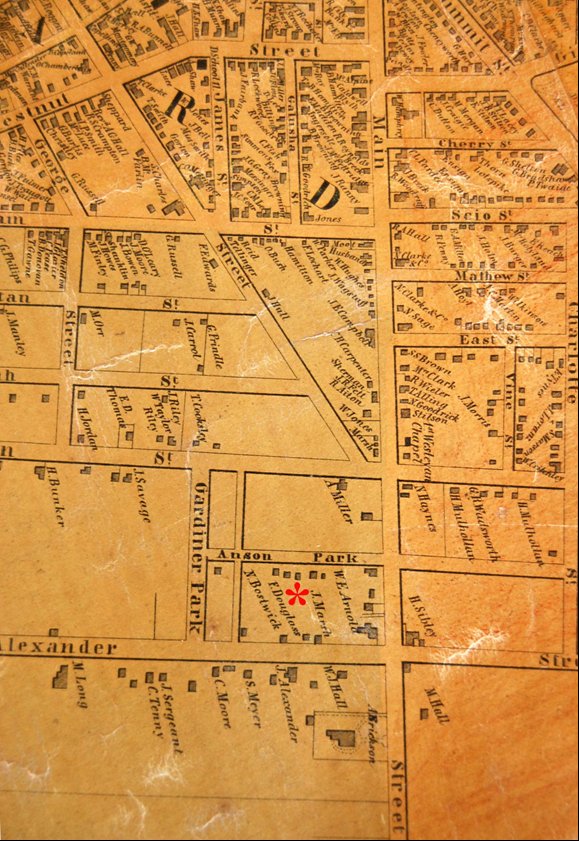

The following is a current tax map for the City of Rochester. Four Alexander is now 297.
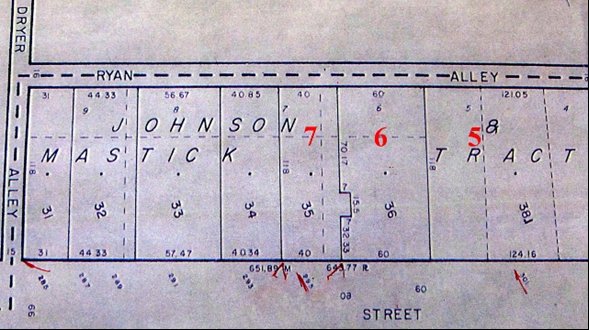
The street at the bottom is Alexander.
The property transactions related to Douglass are:
Joseph Marsh
September 15, 1847
James and Martha Breck sell to Joseph Marsh for $300 a 50' x 121' parcel abutting the north boundary of the property they sold to John Kedzie on August 26, 1846. Deed
February 12, 1848
William E. and Ester Ann Arnold his wife sell to Joseph Marsh for $300 a 20' x 121' parcel to the north of the parcel Marsh bought from James Breck in 1847. Deed
The Marsh Property was a 70' wide parcel in the area marked 5 on the map.
Frederick Douglass
August 26, 1846
James and Martha Breck sell to John Kedzie parcels 6 and 7 for $500. Parcel 6 is 60' x 121' and parcel 7 is 40 x 121. Deed
April 28, 1848
John and Lemira M. Kedzie sell to Frederick Douglass parcels 6 and 7 for $500. Deed
November 17, 1851
Frederick and Anna Douglass sell to Nelson Bostwick parcel 7 for $325 Deed
March 21, 1853
Frederick and Anna Douglass sell to Wait H. Davis parcel 6 for $2200. Deed
There is no information as to when they were built but the 1851 city map shows houses on parcels 5,6 and 7
An indenture dated April 28, 1847 between Frederick Douglass, party of the first part, and John Kedzie of the second part describes the property Douglass will buy. The document then states,
The premises being subject to two certain mortgages for five hundred dollars each and interest, one given by the party of the second part to James Breck and dated August 26, 1846. The other given by said party of the second part to Joseph Medbury and dated April 30, 1847 which said mortgages, the party of the first part, assumes and agrees in consideration of the premises to discharge and pay off. This Grant is intended as a security for the payment of the sum of Five Hundred Dollars to be paid on the first day of May Eighteen hundred forty nine and interest.
An additional mortgage existed while Douglass owned the Alexander Street property. On page 144 Fought states,
Griffiths did, of course, hold the mortgage to the Douglass house at one time. In August 1849, when the future of the North Star has appeared so dire, Eliza Griffiths had loaned Frederick $1000 to stabilize the business, using the house as collateral. When Eliza married John Dick in 1851, they signed the mortgage over to Julia. Julia declared the loan paid in full two years later, in March 1853,
On November 22, 1851, for the sum of $100, Julia Griffiths released the mortgage on the portion of the land sold to Nelson Bostwick.
"School Integration"
Frederick Douglass moved his family to Rochester in early 1848. He enrolled his daughter Rosetta in the Seward Female Seminary which was located on Alexander Street a little south of the Douglass home at 4 Alexander St. He eventually learned Rosetta was being taught separately from the other students. The story is told in Rochester History Vol. 78 No. 2 Racial Segregation in Rochester Schools 1818 - 1856 pgs. 9-14.
https://www.libraryweb.org/~rochhist/v78_/v78i2.pdf
"Colored Churches"
It is well known that the first issue of the North Star is dated December 3, 1847. It is less well known that the second issue was published on January 7, 1848. This is explained by a short column on page 2 of the December 3 paper.
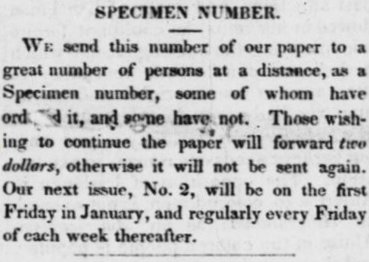
Illegible part: "...ordered it, and some have not...."
Copies of the North Star have been hard to find on-line so information has been missed. This problem has been alleviated by the digitizing of a large number of North Star issues by -the Library of Congress. The link is https://www.loc.gov/collections/frederick-douglass-newspapers/about-this-collection/?loclr=blogser
Those aware of Douglass' time in New Bedford, MA may be surprised by several articles titled "Colored Churches", which appeared in the North Star in February and March 1848. They were inspired by letter a black minister sent to a Springfield, MA newspaper after a Douglass speech in that city.
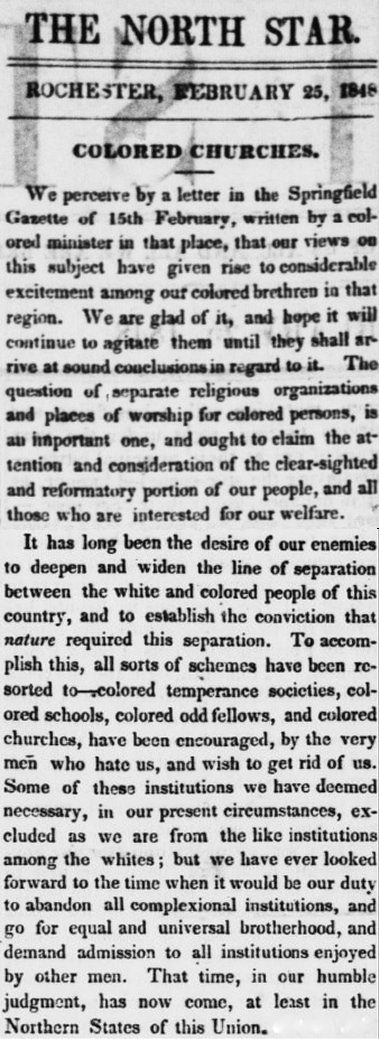
To appreciate Douglass' points, the full articles should be read.
Other articles on the topic are "Colored Churches No. II" North Star, March 3, 1848 p. 2 and "Colored Churches No. III" North Star, March 10, 1848 p. 2

Several groups in Rochester asked Douglass to explain his views, which he did at two meetings, The first at the Ford Street Baptist Church on March 6, 1848 and the second at the Spring Street Zion Church on March 13, 1848. A report on the meetings by William Nell appeared in the North Star of March 24, 1848. It would seem that while Frederick Douglass was active in local church events, he was not a member of a local black church.
Background
Frederick arrived in Rochester a staunch Garrisonian. These followers of William Lloyd Garrison believed in "moral suasion". If people were informed about the evils of slavery their innate moral sense would turn them against it. They believed the Constitution was a pro-slavery document, people should not vote and that the North should succeed from the Union.
In Western New York a different idea developed leading to the formation of the Liberty Party. Rochesterian Myron Holley was a founder of this group whose members believed the Constitution was not a pro slavery document and change could be brought about by political and legal means. Abolition was its sole issue and it became the first anti-slavery political party to run a candidate for President, but as a single issue party it did not get widespread support.
From April, 1846 to February, 1848 the United States fought a war with Mexico. Many saw this as a land grab and abolitionists felt it was an attempt by the South to expand slavery into the West, increase the number of slave states and increase the power of the South in the government. To prevent this, David Wilmot of Pennsylvania attached a rider to a war appropriations bill banning slavery from any territory acquired from Mexico. The "Wilmot Proviso" passed the House but not the Senate.
This called attention to what became known as the "Slave Power" and paved the way for the formation of the Free Soil Party in Buffalo in 1848.
From this point forward the prevention of the expansion of slavery into new territories would become the focus of politicians. . Douglass, a fervent abolitionist, supported the Free Soil Party because he realized it brought the attention of many more people to the evils of slavery.
Now settled in Rochester, Douglass had gotten the North Star off to a journalistically good start and continued to tour to earn money and gain subscribers. In December, 1847, in Springfield, Massachusetts, Douglass, met John Brown. Of Brown he said, "He denounced slavery in look and language fierce and bitter, thought that slaveholders had forfeited their right to live, that slaves had the right to gain their liberty in any way they could, did not believe that moral suasion would ever liberate the slave, or that political action would abolish the system." Douglass describes the meeting in Life and Times, Chapter VIII, John Brown and Mrs. Stowe.
Financial Difficulties
The North Star experienced the predicted financial difficulties. While being one of the best lecturers and writers of his time, Douglass seemed to have little interest in the business side of running a paper. These issues are discussed in Foner, pgs. 84 - 100. A student paper from the University of Rochester also sheds light on this topic. The North Star Ledgers from 1847-1849 and 1850 to 1853 are available on the library of Congress site.
Douglass acknowledged the paper's problems in two letters, both in McKivigan, one from 1848 to Julia Griffiths, an English abolitionist, he met during his trip to Great Britain and the other in 1849 to Gerrit Smith, a founder of the Liberty Party. Both would have consequences.
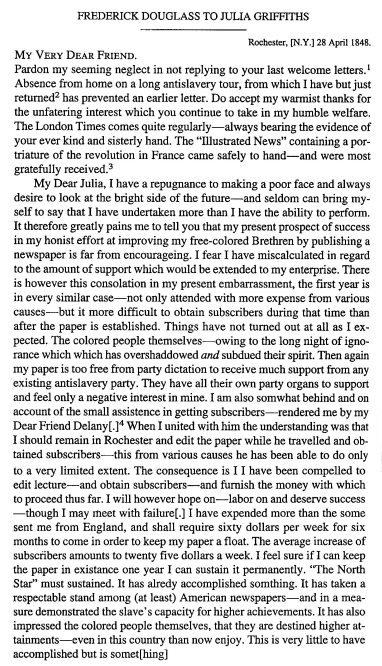
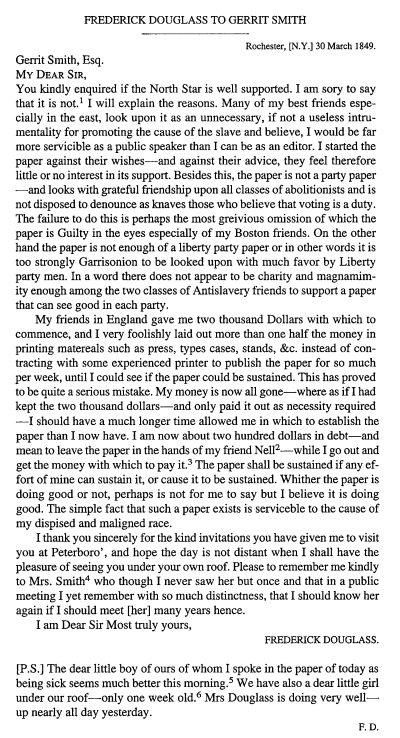
To Julia Griffiths he wrote,
My Dear Julia, I have a repugnance to making a poor face and always desire to look at the bright side of the future - and seldom can bring myself to say that I have undertaken more than I have the ability to perform. It therefore greatly pains me that my present prospect of success in my honest effort at improving my free- colored Brethren by publishing a newspaper is far from encouraging.
The Gerrit Smith letter states,
You kindly enquired if the North Star is well supported. I'm sorry to say it is not. I will explain the reasons. Many of my best friends especially in the east, look upon it as unnecessary, if not useless instrument for promoting the cause of the slave and believe, I would be far more servicible as a public speaker than I can be as an editor. I started the paper against their wishes - and against their advise, they feel therefore little or no interest in its support My friends in England gave me two thousand Dollars with which to commence, and I very foolishly laid out more than one half the money in printing materials such as a press, types cases, stands, &c. instead of contracting with some experienced printer to publish the paper for so much per week, until I could see if the paper could be sustained. This has proved to be quite a serious mistake.
Julia Griffiths and her sister Eliza traveled from England to Rochester arriving in May 1849 and planning to stay in the U.S. for six months. They moved into the Douglass house at 4 Alexander Street, began helping Douglass straighten out his finances and extended their stay. Eliza married John Dick, the North Star printer, in June 1850 and left Rochester. Julia, who had been a bookkeeper in her father's business and had a good business sense, got involved in running the North Star, becoming the business manager. Julia, age 30 and single had found the perfect position. She was able to use her talents in an important cause and be appreciated. Her influence was ignored at first but when it was realized how effective she was, she came under attack by the Garrisonians, especially after Douglass announced he was no longer a proponent of "moral suasion" and believed legal means the best route for ending slavery.
http://teachingamericanhistory.org/library/document/change-of-opinion-announced/This led to attacks on Douglass, using sexual innuendo, and blaming Griffiths for his change of mind. The best source for information is Fought, Chapter 5, "I Won't Have Her in My House," 1848 - 1858. Douglass and Griffiths stood tall during the attacks. Disappointingly, Susan B. Anthony was among the gossipers.
From Life and Times, p. 706,
"But to no one person was I more indebted for substantial assistance than to Mrs. Julia Griffiths Crofts. She came to my relief when my paper had nearly absorbed all my means, and I was heavily in debt, and when I had mortgaged my house to raise money to meet current expenses; and in a single year by her energetic and effective management enabled me to extend the circulation from 2,000 to 4,000 copies, pay off the debts and lift the mortgage from my house. Her industry was equal to her devotion. She seemed to rise with every emergency, and her resources appeared inexhaustible. I shall never cease to remember with sincere gratitude the assistance rendered me by this noble lady, and I mention her here in the desire in some humble measure to "give honor to whom honor is due."
Regarding the second letter, Gerrit Smith, a wealthy abolitionist, was a founder of the Liberty Party and supporter of it's newspaper which did poorly He suggested the paper merge with the North Star with his support. The editor of the Liberty Paper wanted to publish in Syracuse but Douglass insisted on Rochester. He decided that too many things used the name star and decided to rename his paper. The name Frederick Douglass was now well known and unique so it was decided to call the new paper, Frederick Douglass' Paper. The first issue of the new paper was dated June 26, 1851.
Women's Rights
Throughout the financial turmoil Douglass continued writing and lecturing. On July 14, 1848 an announcement appeared in the North Star.

Douglass attended and supported Elizabeth Cady Stanton in having the right to vote included in the Declaration of Sentiments, which he signed. The Report of the Woman's Rights Convention was printed by John Dick in the North Star Office.
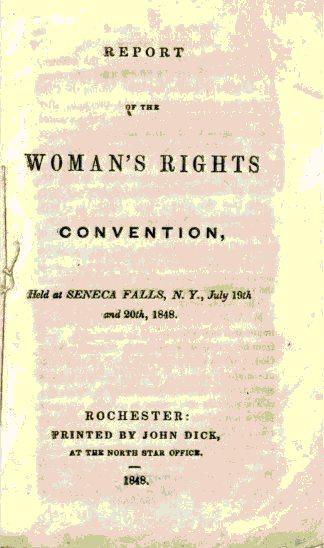
The text of the Report can be found on the Women's Hall of Fame web site.
Two week later, on Wednesday August 2nd, a Woman's Rights Convention was held in Rochester.

Woman's Rights Convention Aug 3 1848
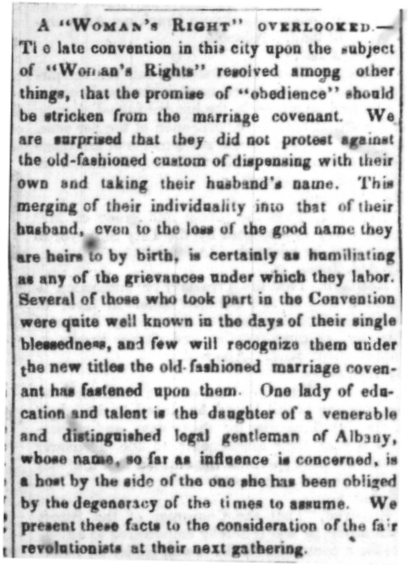

Also in 1848, Douglass took part in the celebration of the abolition of slavery in the British West Indies.
The celebration was described in the Rochester Daily Advertiser.
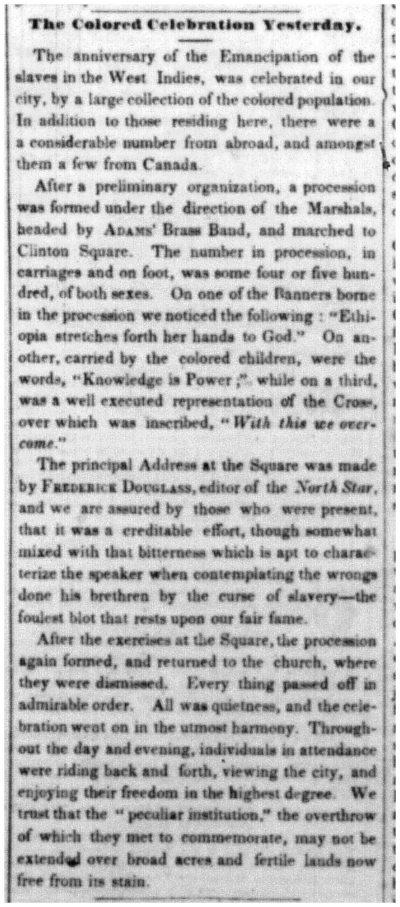
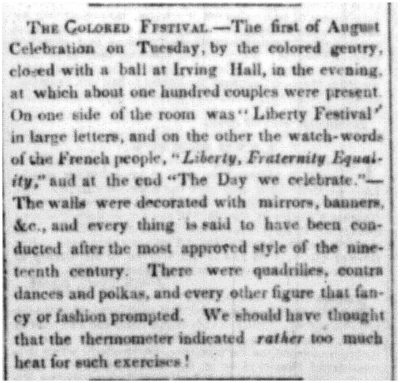
The Emancipation Day celebration was a major event. Two of the speakers were Frederick Douglass and Henry W. Johnson of Canandaigua (HWJ, part 2).
An Emancipation Day celebration is presently held at the Gerrit Smith Estate National Historic Landmark in Peterboro, NY.In the Appendix to Life and Times, Douglass included an "Extract from a speech delivered by Frederick Douglass in Elmira, N.Y., August 1, 1880, at a great meeting of colored people met to celebrate West India emancipation, and where he was received with marked respect and approval by the president of the day and the immense there assembled."
Rochester Ladies Anti-Slavery Sewing Society
During this period, Julia Griffiths became a tireless worker and fund raiser for the North Star. One source of funds were fairs run by abolitionist women. In Rochester, the fairs were organized by Amy Post, for the Western New York Anti-Slavery Society, with most funds going to the American Anti-Slavery Society. The fairs sold both donated goods and items made by members. In 1851 Julia Griffiths organized the Rochester Ladies Anti-Slavery Sewing Society to raise funds for the North Star. Sewing Circles were popular at the time. From the December 3, 1847 Liberator.

The Constitution for the Rochester Ladies Anti-Slavery Sewing Society appeared in the North Star of October 23, 1851.
A collection of papers from the Rochester Ladies Anti-Slavery Sewing Society is held by the University of Michigan. Be sure to scroll down and read the history.
The Sewing Society asked Frederick Douglass to speak at Corinthian Hall in Rochester for the 4th of July, 1852. In 1852, the 4th was on Sunday so the holiday was celebrated on Monday July 5th. This speech is the best known abolitionist speech and appears in many collections of abolitionist and Civil War writings. The speech appeared in Frederick Douglass' Paper on July 9, 1852. The report opened setting the scene.
The complete speech is available through the University of Rochester libraries.
The speech has five main topics. Douglass opens by congratulating the attendees on the celebration and accomplishments of their forefathers, but then asks , "What, to the American slave is your 4th of July". He continues by describing the internal slave trade, the role of religion in ending slavery and concludes with hope. Condensations of these topics follow.
Congratulations
Resolved, That these united colonies are, and of right, ought to be free and Independent States; that are absolved from all allegiance to the British Crown; and that all political connection between them and the State of Great Britain is, and ought to be, dissolved.
Citizens, your fathers Made good that resolution. They succeeded: and today you reap the fruits of their success. The freedom gained is yours; and you, therefore, may properly celebrate this anniversary....
...The signers of the Declaration of Independence were brave men.... ...They were statesmen, patriots and heroes, and for the good they did, and the principles the contended for, I unite with you to honor their memory.
They loved their country better than their own private interests. Your fathers staked their lives, their fortunes, and their sacred honor, on the cause of their country.... ...In their admiration of liberty, they lost sight of all other interests.
...Of this fundamental work, this day is the anniversary. Our eyes are met with demonstrations of joyous enthusiasm. Banners and pennants wave exultingly on the breeze.... ...The ear-piercing fife and the stirring drum unite their accents with the ascending peal of a thousand church bells. Prayers are made, hymns are sung, and sermons are preached in honor of this day...
Question
...Fellow-citizens, pardon me, allow me to ask, why am I called upon to speak here today? What have I, or those I represent, to do with your national independence? Are the great principles of political freedom and of natural justice, embodied in that Declaration of Independence, extended to us?....
...Your high independence only reveals the immeasurable distance between us. The blessings in which you, this day, rejoice, are not enjoyed in common. The rich inheritance of justice, liberty, prosperity and independence, bequeathed by your fathers, is shared by you but not by me. The sunlight that brought life and healing to you, has brought stripes and death to me. This Fourth of July is yours, not mine. You may rejoice, I must mourn....
...What to the American slave, is your 4th of July?...
Internal Slave Trade
...It is called... ...the "internal slave-trade." It is probably, called so, too, in order to divert from it the horror with which the foreign slave-trade is contemplated. That trade has long since been denounced by this government, as piracy. It has been denounced with burning words from the high places of the nation... ...It is, however, a notable fact, that, while so much execration is poured out by Americans, upon those engaged in the foreign slave-trade, the men engaged in the slave-trade between the states pass without condemnation, and their business is deemed honorable. Behold the practical operation of this internal slave-trade, the American slave-trade, sustained by American politics and American religion....
...Fellow-citizens, this murderous traffic is, to-day, in active operation in this boasted republic.... ...I see the bleeding footsteps; I hear the doleful wail of fettered humanity, on the way to the slave markets, where the victims are to be sold like horses, sheep and swine, knocked off to the highest bidder. There I see the tenderest ties ruthlessly broken, to gratify the lust, caprice and rapacity of the buyers and sellers of men. My soul sickens at the sight....
...Is this the land your Fathers loved, The freedom which they toiled to win?...
Role of the Church
...I take this law to be one of the grossest infringements of Christian Liberty, and, if the churches and ministers of our country were not stupidly blind, or most wickedly indifferent, they, too, would so regard it....
...At the very moment that they are thanking God for the enjoyment of civil and religious liberty, and the right to worship God according to the dictates of their own consciences, they are utterly silent in respect to a law which robs religion of its chief significance, and makes it utterly worthless to a world lying in wickedness. Did this law concern the "mint, anise and cumin," -abridge the right to sing psalms, to partake of the sacrament, or engage of any of the ceremonies of religion, it would be smitten by the thunder of a thousand pulpits. A general shout would go up from the church, demanding repeal, repeal, instant repeal! -And it would go hard with that politician who presumed to solicit the votes of the people without inscribing this motto on his banner....
...The fact that the church of our country, (with fractional exceptions,) does not esteem "the Fugitive Slave Law" as a declaration of war against religious liberty, implies that that church regards religion simply as a form of worship, an empty ceremony, and not a vital principle, requiring active benevolence, justice, love and good will towards men. It esteems sacrifice above mercy; psalm-singing above right doing; solemn meetings above practical righteousness....
...The American church is guilty, when viewed in connection with what it is doing to uphold slavery, but is superlatively guilty when viewed in connection with its ability to abolish slavery. The sin of which it is guilty is one of omission as well as commission....
...Let the religious press, the pulpit, the Sunday school, the conference meeting, the great ecclesiastical, missionary, bible and tract associations of the land array their immense powers against slavery, and slave-holding; and the system of crime and blood would br scattered to the winds, and that they do not do this involves them in the most awful responsibility of which the mind can conceive....
Hope
...I will not enlarge further on your national inconsistencies. The existence of slavery in this country brands you republicanism as a sham, your humanity as a base pretence, and your Christianity as a lie. It destroys your moral power abroad it corrupts your politicians at home. It saps the foundation of religion; it makes your name a hissing, and a bye-word to a mocking earth....
...But it is answered in reply to all this, that precisely what I have now denounced is, in fact, guaranteed and sanctioned by the Constitution of the United States; that the right to hold, and to hunt slaves is a part of the Constitution frames by the illustrious Fathers of this Republic. Then, I dare affirm, notwithstanding all I have said before, your fathers stooped, basely stooped.... ...And instead of being the honest men I have before declared them to be, they were the veriest imposters that ever practiced on mankind. This is the inevitable conclusion, and from it there is no escape; but I differ from those who charge this baseness on the framers of the Constitution of the United States. It is a slander upon their memory, at least I so believe....
...in that instrument I hold there is neither warrant, license, nor sanction of the hateful thing; but interpreted, as it ought to be interpreted, the Constitution is a GLORIOUS LIBERTY DOCUMENT. Read its preamble, consider its purposes. Is slavery among them? Is it at the gateway? Or is it in the temple? It is neither....
...take the constitution according to its plain reading, and I defy the presentation of a single pro-slavery clause in it. On the other hand it will be found to contain principles and purposes entirely hostile to the existence to slavery....
...Allow me to say, in conclusion, notwithstanding the dark picture I have this day painted, of the state of the nation, I do not despair of this country. There are forces in operation, which must inevitably, work the downfall of slavery....
...I, therefore, leave off where I began, with hope....
Rochester Athenaeum / Corinthian Hall
Resolved, That these united colonies are, and of right, ought to be free and Independent States; that are absolved from all allegiance to the British Crown; and that all political connection between them and the State of Great Britain is, and ought to be, dissolved.
Citizens, your fathers Made good that resolution. They succeeded: and today you reap the fruits of their success. The freedom gained is yours; and you, therefore, may properly celebrate this anniversary....
...The signers of the Declaration of Independence were brave men.... ...They were statesmen, patriots and heroes, and for the good they did, and the principles the contended for, I unite with you to honor their memory.
They loved their country better than their own private interests. Your fathers staked their lives, their fortunes, and their sacred honor, on the cause of their country.... ...In their admiration of liberty, they lost sight of all other interests.
...Of this fundamental work, this day is the anniversary. Our eyes are met with demonstrations of joyous enthusiasm. Banners and pennants wave exultingly on the breeze.... ...The ear-piercing fife and the stirring drum unite their accents with the ascending peal of a thousand church bells. Prayers are made, hymns are sung, and sermons are preached in honor of this day...
...Fellow-citizens, pardon me, allow me to ask, why am I called upon to speak here today? What have I, or those I represent, to do with your national independence? Are the great principles of political freedom and of natural justice, embodied in that Declaration of Independence, extended to us?....
...Your high independence only reveals the immeasurable distance between us. The blessings in which you, this day, rejoice, are not enjoyed in common. The rich inheritance of justice, liberty, prosperity and independence, bequeathed by your fathers, is shared by you but not by me. The sunlight that brought life and healing to you, has brought stripes and death to me. This Fourth of July is yours, not mine. You may rejoice, I must mourn....
...What to the American slave, is your 4th of July?...
...It is called... ...the "internal slave-trade." It is probably, called so, too, in order to divert from it the horror with which the foreign slave-trade is contemplated. That trade has long since been denounced by this government, as piracy. It has been denounced with burning words from the high places of the nation... ...It is, however, a notable fact, that, while so much execration is poured out by Americans, upon those engaged in the foreign slave-trade, the men engaged in the slave-trade between the states pass without condemnation, and their business is deemed honorable. Behold the practical operation of this internal slave-trade, the American slave-trade, sustained by American politics and American religion....
...Fellow-citizens, this murderous traffic is, to-day, in active operation in this boasted republic.... ...I see the bleeding footsteps; I hear the doleful wail of fettered humanity, on the way to the slave markets, where the victims are to be sold like horses, sheep and swine, knocked off to the highest bidder. There I see the tenderest ties ruthlessly broken, to gratify the lust, caprice and rapacity of the buyers and sellers of men. My soul sickens at the sight....
...Is this the land your Fathers loved, The freedom which they toiled to win?...
Role of the Church
...I take this law to be one of the grossest infringements of Christian Liberty, and, if the churches and ministers of our country were not stupidly blind, or most wickedly indifferent, they, too, would so regard it....
...At the very moment that they are thanking God for the enjoyment of civil and religious liberty, and the right to worship God according to the dictates of their own consciences, they are utterly silent in respect to a law which robs religion of its chief significance, and makes it utterly worthless to a world lying in wickedness. Did this law concern the "mint, anise and cumin," -abridge the right to sing psalms, to partake of the sacrament, or engage of any of the ceremonies of religion, it would be smitten by the thunder of a thousand pulpits. A general shout would go up from the church, demanding repeal, repeal, instant repeal! -And it would go hard with that politician who presumed to solicit the votes of the people without inscribing this motto on his banner....
...The fact that the church of our country, (with fractional exceptions,) does not esteem "the Fugitive Slave Law" as a declaration of war against religious liberty, implies that that church regards religion simply as a form of worship, an empty ceremony, and not a vital principle, requiring active benevolence, justice, love and good will towards men. It esteems sacrifice above mercy; psalm-singing above right doing; solemn meetings above practical righteousness....
...The American church is guilty, when viewed in connection with what it is doing to uphold slavery, but is superlatively guilty when viewed in connection with its ability to abolish slavery. The sin of which it is guilty is one of omission as well as commission....
...Let the religious press, the pulpit, the Sunday school, the conference meeting, the great ecclesiastical, missionary, bible and tract associations of the land array their immense powers against slavery, and slave-holding; and the system of crime and blood would br scattered to the winds, and that they do not do this involves them in the most awful responsibility of which the mind can conceive....
Hope
...I will not enlarge further on your national inconsistencies. The existence of slavery in this country brands you republicanism as a sham, your humanity as a base pretence, and your Christianity as a lie. It destroys your moral power abroad it corrupts your politicians at home. It saps the foundation of religion; it makes your name a hissing, and a bye-word to a mocking earth....
...But it is answered in reply to all this, that precisely what I have now denounced is, in fact, guaranteed and sanctioned by the Constitution of the United States; that the right to hold, and to hunt slaves is a part of the Constitution frames by the illustrious Fathers of this Republic. Then, I dare affirm, notwithstanding all I have said before, your fathers stooped, basely stooped.... ...And instead of being the honest men I have before declared them to be, they were the veriest imposters that ever practiced on mankind. This is the inevitable conclusion, and from it there is no escape; but I differ from those who charge this baseness on the framers of the Constitution of the United States. It is a slander upon their memory, at least I so believe....
...in that instrument I hold there is neither warrant, license, nor sanction of the hateful thing; but interpreted, as it ought to be interpreted, the Constitution is a GLORIOUS LIBERTY DOCUMENT. Read its preamble, consider its purposes. Is slavery among them? Is it at the gateway? Or is it in the temple? It is neither....
...take the constitution according to its plain reading, and I defy the presentation of a single pro-slavery clause in it. On the other hand it will be found to contain principles and purposes entirely hostile to the existence to slavery....
...Allow me to say, in conclusion, notwithstanding the dark picture I have this day painted, of the state of the nation, I do not despair of this country. There are forces in operation, which must inevitably, work the downfall of slavery....
...I, therefore, leave off where I began, with hope....
Rochester Athenaeum / Corinthian Hall
...I take this law to be one of the grossest infringements of Christian Liberty, and, if the churches and ministers of our country were not stupidly blind, or most wickedly indifferent, they, too, would so regard it....
...At the very moment that they are thanking God for the enjoyment of civil and religious liberty, and the right to worship God according to the dictates of their own consciences, they are utterly silent in respect to a law which robs religion of its chief significance, and makes it utterly worthless to a world lying in wickedness. Did this law concern the "mint, anise and cumin," -abridge the right to sing psalms, to partake of the sacrament, or engage of any of the ceremonies of religion, it would be smitten by the thunder of a thousand pulpits. A general shout would go up from the church, demanding repeal, repeal, instant repeal! -And it would go hard with that politician who presumed to solicit the votes of the people without inscribing this motto on his banner....
...The fact that the church of our country, (with fractional exceptions,) does not esteem "the Fugitive Slave Law" as a declaration of war against religious liberty, implies that that church regards religion simply as a form of worship, an empty ceremony, and not a vital principle, requiring active benevolence, justice, love and good will towards men. It esteems sacrifice above mercy; psalm-singing above right doing; solemn meetings above practical righteousness....
...The American church is guilty, when viewed in connection with what it is doing to uphold slavery, but is superlatively guilty when viewed in connection with its ability to abolish slavery. The sin of which it is guilty is one of omission as well as commission....
...Let the religious press, the pulpit, the Sunday school, the conference meeting, the great ecclesiastical, missionary, bible and tract associations of the land array their immense powers against slavery, and slave-holding; and the system of crime and blood would br scattered to the winds, and that they do not do this involves them in the most awful responsibility of which the mind can conceive....
...I will not enlarge further on your national inconsistencies. The existence of slavery in this country brands you republicanism as a sham, your humanity as a base pretence, and your Christianity as a lie. It destroys your moral power abroad it corrupts your politicians at home. It saps the foundation of religion; it makes your name a hissing, and a bye-word to a mocking earth....
...But it is answered in reply to all this, that precisely what I have now denounced is, in fact, guaranteed and sanctioned by the Constitution of the United States; that the right to hold, and to hunt slaves is a part of the Constitution frames by the illustrious Fathers of this Republic. Then, I dare affirm, notwithstanding all I have said before, your fathers stooped, basely stooped.... ...And instead of being the honest men I have before declared them to be, they were the veriest imposters that ever practiced on mankind. This is the inevitable conclusion, and from it there is no escape; but I differ from those who charge this baseness on the framers of the Constitution of the United States. It is a slander upon their memory, at least I so believe....
...in that instrument I hold there is neither warrant, license, nor sanction of the hateful thing; but interpreted, as it ought to be interpreted, the Constitution is a GLORIOUS LIBERTY DOCUMENT. Read its preamble, consider its purposes. Is slavery among them? Is it at the gateway? Or is it in the temple? It is neither....
...take the constitution according to its plain reading, and I defy the presentation of a single pro-slavery clause in it. On the other hand it will be found to contain principles and purposes entirely hostile to the existence to slavery....
...Allow me to say, in conclusion, notwithstanding the dark picture I have this day painted, of the state of the nation, I do not despair of this country. There are forces in operation, which must inevitably, work the downfall of slavery....
...I, therefore, leave off where I began, with hope....
Rochester Athenaeum / Corinthian Hall
The Rochester Athenaeum was founded at a meeting in the Reynolds Arcade on June 12, 1829. Nathaniel Rochester was its first president. Its purpose was to promote literature, science and the arts. From 1849 to 1871, the Athenaeum occupied the Athenaeum Building built for it by William Reynolds, son of Abelard. This building was behind the Reynolds Arcade and its upper floors were an 1100 seat hall, Corinthian Hall. For a quarter century this hall was a major feature of Rochester's cultural and intellectual life.

The above is from the 1926 plat map. The theater is now Corinthian Theater not Corinthian Hall. It is located just above the CO in CORINTHIAN ST. This street was originally named Works Street. In 1850 the name was changed to Exchange Place and eventually to Corinthian Street.
The Athenaeum Building RDD June 29 1849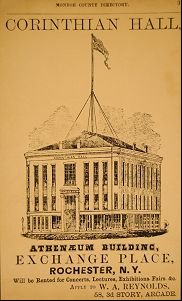
Rochester Public Library Local History Division

Rochester Public Library Local History Division
The local economy was depressed after the Civil War and William A. Reynolds had to sell the Athenaeum Building. The Athenaeum had a lease until 1871 so it had time to plan its move. The Academy of Music moved into the Athenaeum Building and the Athenaeum moved into the Rochester Savings Bank rent free. After the move things changed and instead of a vibrant institution, the Athenaeum became an upstairs library outside the mainstream of cultural life. In 1876 it was evicted from the bank building and in 1877 sold its books to pay creditors. From this point on it existed mainly in name only although it still had about $3000 in cash and securities held by the Rochester Savings Bank.
In 1885 Bausch and Lomb were having a problem finding skilled workers for their plants. They concluded the training school students received was inadequate. Henry Lomb teamed with Max Lowenthal, a local knitted goods manufacturer, and endorsed by over fifty local industries, formed the Mechanics Institute. The goal was to train students to use tools but not necessarily teach them a vocation. The first year classes were conducted in the gymnasium of the Rochester Free Academy building. This proved inadequate so the Institute moved to the Smith and Perkins Building at 13 Exchange Street the next year. In 1891 possibly looking for prestige and money it was suggested the Mechanics Institute merge with the Rochester Athenaeum. Both parties agreed and The Rochester Athenaeum and Mechanics Institute was formed on May 30, 1891.
Later in 1891 it was decided to build a campus. Land between Spring Street and the canal in the vicinity of Washington Street and Plymouth Avenue was purchased. The first building was constructed in 1894. The area is shown on a 1926 map.
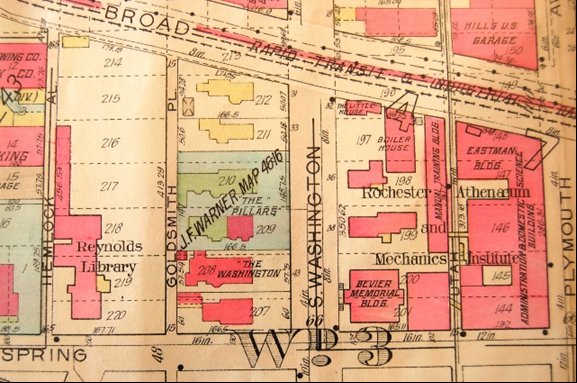
Over the years the Institute changed and the name no longer represented the range of studies available. The name was changed to the Rochester Institute of Technology in 1944. In the decades after the Second World War, RIT experienced a boom in enrollment. By the late 1950's it was in need of space for academic buildings, dorms and parking. In the downtown area space was in short supply, land was expensive and the difficulties were compounded when the state announced it was going to build an expressway through the campus. On November 20, 1961 the Board voted to move the campus to Henrietta. The first classes on the Henrietta campus were held in September, 1968.
https://www.rit.edu/overview/history-rit
The Hall was dedicated at the end of June 1849 and became the center of Rochester's cultural life. Some events, other than Douglass' 5th of July speech, of local interest follow.
Fox Sisters
In 1848 two sisters, Kate and Margaret Fox, from Hydesville, NY began communicating with the spirit world. They would be joined by a third sister Leah, who had married and was living on Troup Street in Rochester. It was one of these spirits that told the Fox sisters to conduct a demonstration of their powers at Corinthian Hall. This was done November 14-17, 1849. The presentation would open with a lecture which presented the "rappings" as a new scientific discovery, not an occult occurrence, followed by a demonstration of the "rappings". At the end of each evening five people were chosen to form a committee to examine the sisters and report back the next evening. The story can be told through local newspaper clippings.

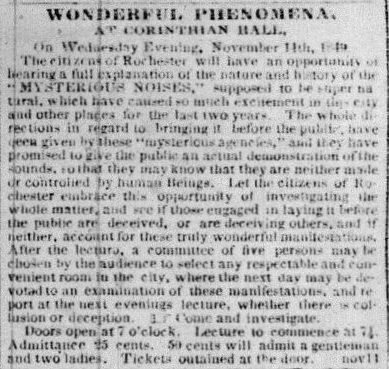
Prices were reduced for the last two demonstrations.
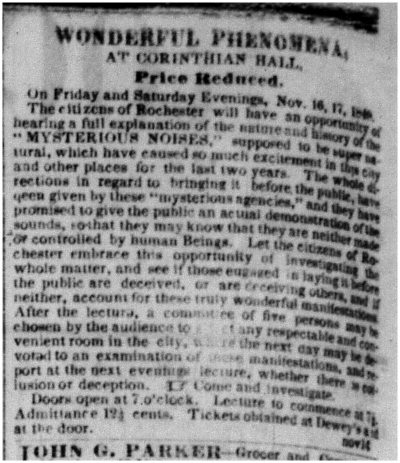
Some other newspaper accounts are:
- Fox Sisters A Ghost RDD Nov 16 1849
- Fox Sisters Myterious Knocking RDD Nov 17 1849
- Fox Sisters Myterious Knocking RDD Nov 17 1849
The abolitionists Amy and Isaac Post were proponents of Spiritualism. Isaac wrote an 1852 book "Voices from the Spirit World". Post writes, " To me the subject of man's present and future condition is of vast importance; and, since I have found my pen moved by some power beyond my own, either physical or mental, and believing it to be the spirits of those who have inhabited bodies, and passed from sight, I feel it best to allow those, who desire to read the words of many individuals, as they have written with my hand, the privilege of doing so." George Washington and Thomas Jefferson were among those moving Isaac's hand.
Frederick Douglass was not a believer. From a repot on a Spiritualist Convention in the RUA, August 27, 1868, 2-3. Fred. Douglass was invited to address the audience and consented to do so. He expressed his sympathy with the Convention in its purposes to effect reform as beneficial to mankind, but did not understand the Spiritual views of those who professed to entertain them.
While Amy Post is often cited as an influence in bringing Douglass to Rochester, some say there was a bit of a falling out. When the North Star was having its initial problems, people felt its finances were poorly managed. Amy and Isaac suggested the financials be run by a local committee. Frederick was outraged to have his management challenged. He decided to keep the financial management under his control but agreed to let a committee go over his books. This was rendered moot when Julia Griffiths became the business manager of the North Star. Two letters, one to Amy and one to Isaac, give some insight.
Julia Griffiths formation of the Rochester Ladies Antislavery Sewing Society which supplanted Amy's WNY Anti-Slavery Society's women's group and Douglass' move away from "moral suasion" which the Posts believed in, may also have caused friction. A prominent Spiritualist visited Rochester in November, 1894. In 1926 he wrote a two volume History of Spiritualism. It was Sir Arthur Conan Doyle.
The Music Hall was in the YMCA building then located on the NE corner of what is now South Avenue and Court Street.
http://www.victorianweb.org/authors/doyle/spiritualism.html
Jenny Lind
The original inductees to the Rochester Music Hall of Fame were chosen in 2011. Included were Corinthian Hall as a venue and the July, 1851 performances of Jenny Lind at Corinthian Hall as an event. The following, was taken, with permission, directly from the Hall of Fame website.
The Performances of Mademoiselle Jenny Lind, the "Swedish Nightingale" (event) (Performance Dates: July 22 and July 24, 1851) Johanna Maria "Jenny" Lind - (b. Oct. 6, 1820 - d. Nov. 2, 1887)
The Swedish soprano Mademoiselle Jenny Lind known as the "Swedish Nightingale" was one of the most highly regarded singers of the 19th century. At the height of her fame she was persuaded by the showman P.T Barnum to undertake a long tour of the United States. The tour began in September 1850 and continued to May 1852. Barnum's advance publicity made Lind a celebrity even before she arrived in the U.S., and tickets for her first concerts were in such demand that Barnum sold them by auction. The tour provoked a popular furor dubbed "Lind Mania" by the local press.
In July of 1851, a parade of grand vocal and instrumental concerts took place at Corinthian Hall in Rochester including Jenny Lind and her tour group. On July 22 and 24 Rochester witnessed two of the most unforgettable performances it had ever seen.
Jenny Lind arrived at the train station (then on Goodman St.) and was met by the Mayor, and a throng of fans. The Mayor scurried off with her by carriage through back roads to escape the adoring fans and get her safely to the Eagle Hotel in the heart of the city. After arriving at the hotel, she greeted her fans from a balcony and acknowledged the applause from the crowd gathered in the streets below.
Assisting Jenny Lind in concert were Signor Billeti, her pianist, Otto Goldschmidt, her piano accompanist, and Joseph Burke, her violinist. She performed a variety of songs including arias by Bellini and Donizetti, as well as one from Handel's Messiah.
An article written afterwards read, "Jenny Lind Sings at the Corinthian Hall. Demand to see her was so great that tickets to her second performance were auctioned. The proceeds over the regular price, $2,500 were donated to local charities. She also gave a private performance for four Indian Chiefs at the Eagle Hotel." It's hard to imagine who could cause such a stir today.
From the Rochester Daily Advertiser of July 24th,
THAT ECHO. - We are informed on reliable authority, that Jenny Lind's Echo Song was distinctly heard on the corner of Clinton and Andrews streets, a distance of half a mile - perhaps more.
FURTHER YET. - We are informed by the same authority, that the Echo Song was distinctly heard on Elm Street, as was several others.
AND STILL FURTHER. - The notes of the Nightingale were plainly heard on North Street - over one mile from the place of singing. These examples show the wonderful volume of her voice, and the great power with which it is put forth on the quivering and vibrating air.
And from July 26th,
CALLING HER OUT. - Last night, after the Concert, about 4000 persons assembled in front of the Eagle Hotel, and would not be satisfied until JENNY LIND appeared on the Balcony, and bowed to the multitude. It is a wonder some of them did not call on her for a speech, in the excess of their enthusiasm.
Other articles of interest,
- Jenny Lind Program RDD July 21 1851 2-7
- Jenny Lind First Demonstration RDA July 24 1851 2-3
- Jenny Lind Concert RDD July 22, 2-5
- Jenny Lind Ticket Auction RDA July 26 1851 3-2
- Jenny Lind RDD July 26 02 1851 2-4
Irrepressible Conflict
William Seward, from Auburn, NY, governor of New York from 1839 to 1842 and a U.S. senator from 1849 to 1861, expected to be the Republican presidential candidate for the 1860 election. He was known for anti-slavery speeches and on October 25, 1858 at Corinthian Hall in Rochester gave the speech that would sink his candidacy.
He said,
Our country is a theater which exhibits in full operation two radically different political systems: the one resting on the basis of servile labor, the other on the basis of voluntary labor of free men....
It is an irrepressible conflict between two opposing and enduring forces, and it means that the United States must and will sooner or later become either entirely a slave-holding nation or entirely a free-labor nation....
This phrase was taken to mean there would be a war between the North and South. A political cartoon appeared showing the sinking Republican boat with the Republicans trying to throw Seward overboard.
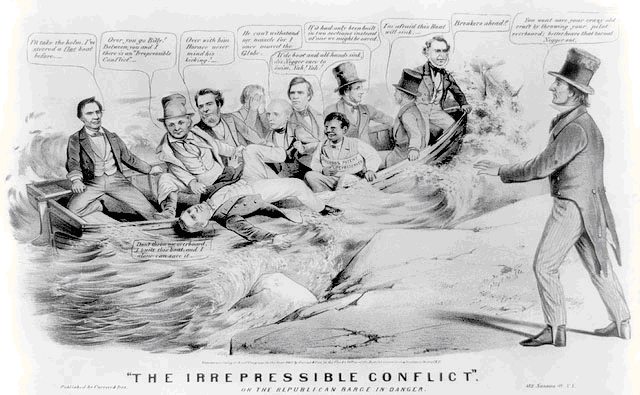
Click on image for a higher resolution version. Source: http://www.loc.gov/pictures/item/2003674592/
At the Republican 1860 Convention, Lincoln became the nominee outpolling Seward on the third ballot. When the Democrats split, with the Northern Democrats nominating Stephen A. Douglass and the Southern Democrats John Breckinridge, Lincoln won the election of 1860, receiving 39.8% of the popular vote. Stephen A. Douglass received 29.5 %, Breckinridge 18.3% and the fourth candidate John Bell 12.6%.
In New York State, Lincoln received 57.3% of the vote and Stephan A. Douglas 46.7 %. Breckinridge and Bell were not on the ballot. Lincoln carried the city of Rochester by a 56.2% to 43.8% margin. In the 1864 election, Lincoln would win the county but lose the city to General McClelland by 74 votes.
There was a referendum on universal black suffrage on the 1860 New York ballot. It lost by a margin of 63.6% to 36.4%. In Rochester it lost 64.3% to 35.7%. Black male voting was allowed but was subject to a property owning restriction. The referendum called for removing this restriction.
With Lincoln's election, Southern states began to secede from the Union. South Carolina left on December 20, Mississippi on January 9, Florida on January 10 and Alabama on January 11. Georgia, Louisiana and Texas would soon follow.
Abolitionist Meeting 1861
Frederick Douglass and Susan B. Anthony had scheduled an abolitionist meeting at Corinthian Hall on January 11 and 12. When a banner, "No Compromise With Slaveholders", appeared on the Reynold's Arcade; tempers flared. The first meeting was taken over by outsiders and abolitionists were prevented from speaking. The meeting was shut down by local authorities, the banner removed and scheduled sessions moved to a local church.
From local newspapers.


A description of the events can be found at Rochester History, Vol. XLVI, January and April, 1984, Nos. 1 and 2, pgs. 14 - 17.
Rochester's Part in the Civil War is the title of the January 1961 issue of Rochester History.On April 18 a meeting was held in City Hall to discuss the war and several resolutions were passed.


After the January disruptions, an Abolitionist meeting was held at Zion's Methodist Episcopal Church. The speaker was Parker Pillsbury. An account appeared in Douglass' Monthly April 1861. It seems to have been written by Douglass himself. He reports, "The church is a small one, owned by the colored people, and is now in these cowardly and compromising times, the only public building in Rochester where an abolition lecture can be delivered." And later, "At the close of Mr. Pillsbury's lecture, we were called upon for a word, and upon briefly responding, was soon made the subject of vigorous criticism by Miss Susan B. Anthony, for attending Plymouth Church. The inconsistency of our attending a church, the doors of which are known to be open to the cause of all other heathen but the heathen in our own land - a church where even Rev. Dr. Cheever is not permitted to plead the cause of the slave - was set in a very glaring light."
Douglass provided a report in the April 1861 Douglass' Monthly.
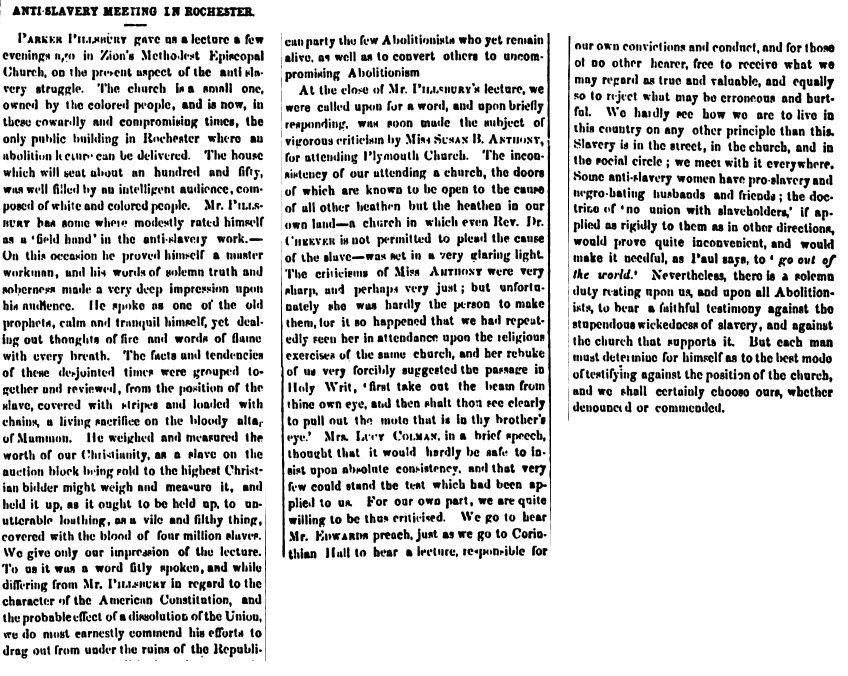
Douglass did not hesitate printing different or critical opinions. He was confident of his positions.
id="lectureseries"Lecture Series
The thread we have been following is events which occurred in Corinthian Hall. We'll now return to a more chronological order. It has been mentioned that at the Emancipation Day celebration in 1848, Douglass spoke in Minerva Hall. From the Local History card file:
Minerva Hall
Occupied two upper stories of the Minerva Block erected late in 1844 on south east corner of Main & South St. Paul streets. Dimensions: 99ft. long, 48 ft. wide, 21ft. high. Seating capacity 2000. Lighted by two tiers of windows the upper tier to be used for ventilation. Two entrances, one from St. Paul St. & one from Main. Principal entrance on Main, by three flights of stairs, five feet wide, of easy ascent.
Rochester Daily Democrat, Dec. 6, 1844, 2:3. Description of site in Peck, Rochester and Monroe County (1908) v2:804.
Minerva Hall appears to be Rochester's leading event space until Corinthian Hall was built in 1849.
In the North Star of February 16, 1849, William C. Nell, reported on a series of six lectures delivered during the winter of 1848 - 49 by Frederick Douglass in Rochester's Minerva Hall.
For six successive Sunday evenings, Frederick Douglass has addressed the citizens of Rochester on the subject of American Slavery. The series have been delivered in Minerva Hall,(the most spacious in the city,) which has been crowded with highly respectable and intelligent audiences, whose interest and attention manifestly increased, to the finale, on the evening of the 11th inst." A condensation follows. The first lecture descried the system of slavery existing in the southern states and another how the north sustained the system by not taking political and religious action. Examples he used were churches making blacks sit in separate sections and receive communion after the whites, the exclusion of black students from schools and the requirement that in New York a black man had to own two hundred fifty dollars in property in order to vote. Nell writes, "and though the citizens of Rochester are a notable exception to the general rule yet there are enough thus infected to profit by the application administered by the lecture." Douglass also discussed the history of the abolition movement, John Calhoun a supporter of illimitable slavery and concluded by speaking "of the many favorable signs of a speedy triumph of right over might.
As an aside Minerva Hall was destroyed by fire in 1858. It occurred after a celebration of the laying of the first transatlantic cable in early August 1858. Two columns in the Union & Advertiser of August 18, 1858 tell the story.
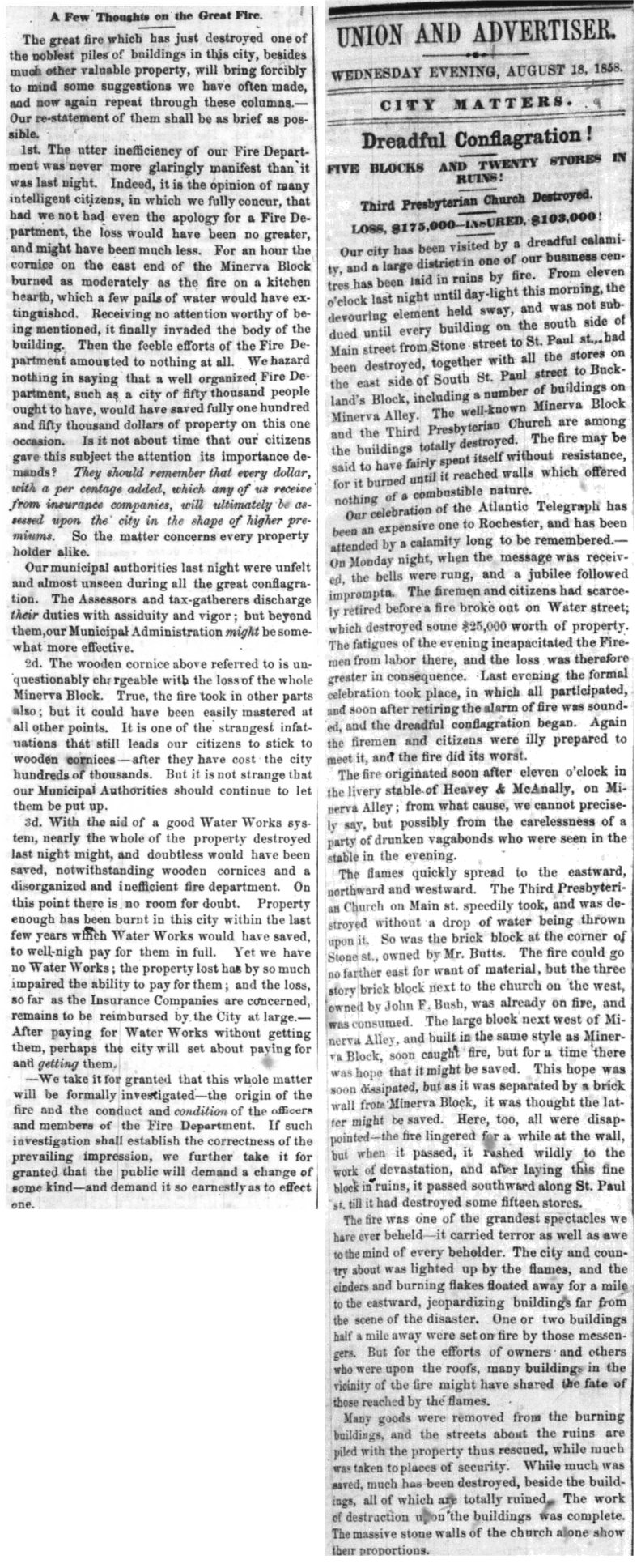
In the winter of 1850 - 1851 Douglass delivered a series of Sunday night lectures in Corinthian Hall. His purpose was to educate the press, pulpit and people about slavery. The first lecture was delivered on Sunday Dec. 1, 1850 and published in the North Star of Dec. 5. The opening, giving his reasons for the lecture series, is copied below.
I come before you this evening to deliver the first of a course which I purpose to give in this city, during the present winter, on the subject of American Slavery.
I make this announcement with no feelings of self-sufficiency. If I do not mistake my own emotions, they are such as result from a profound sense of my incompetency to do justice to the task which I have just announced, and have now entered upon.
If any, then, demand of me why I speak, I plead as my apology, the fact that abler and more eloquent men have failed to speak, or what, perhaps is more true, and therefore more strong, such men have spoken only on the wrong side of the question, and have thus thrown their influence against the cause of liberty, humanity and benevolence.
There are times in the experience of almost every community, when even the humblest member thereof may properly presume to teach - when the wise and great ones, the appointed leaders of the people, exert their powers of mind to complicate, mystify, entangle and obscure the simple truth - when they exert the noblest gifts which heaven has vouchsafed to man to mislead the popular mind, and to corrupt the public heart,- then the humblest may stand forth and be excused for opposing even his weakness to the torrent of evil.
That such a state of things exists in this community, I have abundant evidence. I learn it from the Rochester press, from the Rochester pulpit, and in my intercourse with the people of Rochester. Not a day passes over me that I do not meet with apparently good men, who utter sentiments in respect to this subject which would do credit to savages. They speak of the enslavement of their fellow-men with an indifference and coldness which might be looked for only in men hardened by the most atrocious and villainous crimes.
The fact is, we are in the midst of a great struggle. The public mind is widely and deeply agitated; and bubbling up from its perturbed waters, are many and great impurities, whose poisonous miasma demands a constant antidote.

Beginning December 1st, the January 12 lecture would be the 7th of the series. It concerned the Fugitive Slave Law, laying the blame for its enforcement, on politicians and the clergy. Two excerpts follow:

Douglass' constant attacks on religion and the church would lose him the support of some black clergymen.
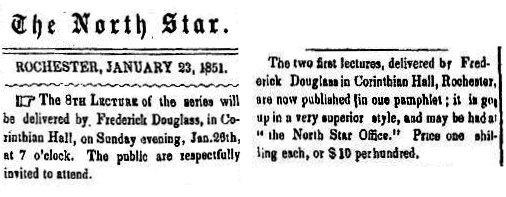
A report on Lecture 8 is in the North Star issue of January 30,1851. Douglass starts by noting the prejudice of the British for the Irish and points out it is based on religion not race. The North Star clips above are from the New York Public Library Collection and the January 30 issue from St. John Fisher College.

He goes on to discuss the Fugitive Slave Law and its effect on free blacks, showing how politics, laws and religion contribute to their problems.
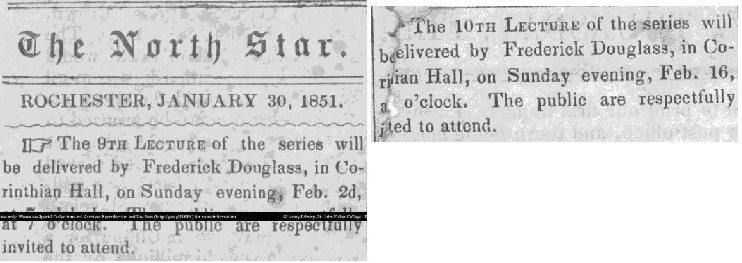
Inability to find sequential issues of the North Star make it impossible to say if the tenth lecture was the last in the series. In the days before computers and web searches Foner thought the series was seven lectures.
The Negro Convention Movement
The Convention Movement was meetings of free black men to discuss not only slavery but other issues of interest to the black community. The Movement is discussed in Foner, Frederick Douglass, The Citadel Press, 1969 pages 107 - 126. Two of the Conventions are of interest here.
The first was held in Troy, NY on July 6,7,8 and 9, 1847. This is the time period Douglass was announcing he would publish an anti-slavery newspaper called the North Star in Cleveland , Ohio. It is of interest because a proposal was made by Reverend Henry Highland Garnet for a national colored press. A special committee headed by Dr. James McCune Smith, was in favor of the proposal.
Douglass opposed it and was accused of acting in his own self interest. The resolution passed 27 to 9. In the January 14, 1848 edition of the North Star Douglass explained his position.

A Colored National Convention was held in Rochester July 6,7,8 and 9, 1853.
The Proceedings were printed at the office of F. Douglass' paper (Rochester, NY). Pages 3, 4 and 5 give the reasons for calling the Convention, among which were, "- The Fugitive Slave Act, the most cruel, unconstitutional and scandalous outrage of modern times - the proscriptive legislation of several States with a view to drive our people from their borders - the exclusion of our children from schools supported by our money - the prohibition of the exercise of the franchise - the exclusion of colored citizens from the jury box - the social barriers against our learning trades - the wily and vigorous efforts of the American Colonization Society to employ the arm of the government to expel us from our native land - ..........."
Pages 7 to 18 are the Address Of The Colored National Convention To The People Of The United States. Although the document bears five signatures, it is widely believed to be mostly the work of Frederick Douglass. It states what the black community expected from the people and government of the United States and is worth reading today.
Pages 18 and 19 describe a National Council of the Colored People.

Douglass was very involved in Article 3, the formation of a manual labor school. The report of this committee begins on page 30. There was a part of the black community that believed once separate schools and institutions in general were accepted, they would remain separate and opposed their formation. Douglass worked for the formation of a school, but expected support, from people like Harriet Beecher Stowe, never materialized.
An article titled "Learn Trades or Starve" appeared in the North Star on March 3, 1853.

Reports on the Convention appeared in the Rochester newspapers. The following are from the Rochester Daily Democrat.
RDD, July 8, 1853
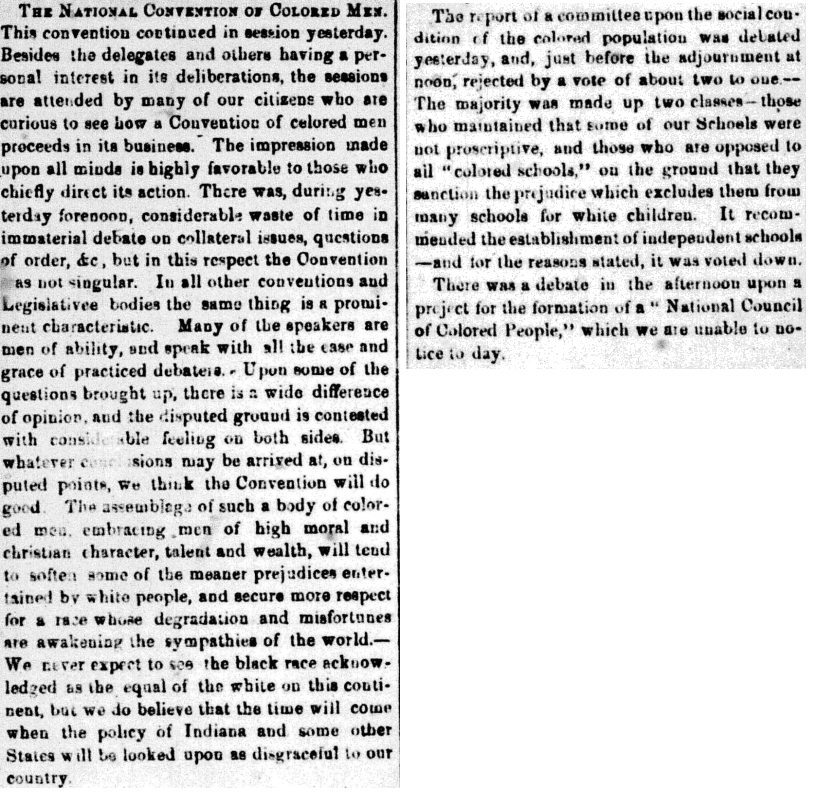
RDD, July 11, 1853

RDD, July 9, 1853

The above article was on the discussion of colonization.
The first link below is for a brief history of the American Colonization Society. The second link is for a Douglass 1849 speech on colonization and the third for an 1894 Douglass speech.
http://www.pbs.org/wgbh/aia/part3/3p1521.html
http://utc.iath.virginia.edu/abolitn/abar03at.html
http://teachingamericanhistory.org/library/document/the-folly-of-colonization/
The Compromise of 1850
The Compromise of 1850 was a group of bills designed to settle the debate over the fate of the land acquired during the war with Mexico. Included was the Fugitive Slave Law which created outrage in the north because it required officials and citizens to assist in the capture of accused escaped slaves. Further, helping an escaped slave could bring six months in jail and a one thousand dollar fine. To many northerners slavery was an abstract thing happening hundreds of miles away. This law brought slavery to their attention and gave abolitionists a target to attack, the "slave power".
- https://en.wikipedia.org/wiki/Compromise_of_1850
- https://en.wikipedia.org/wiki/Fugitive_Slave_Act_of_1850
As the Compromise was being discussed in Washington, an abolitionist convention was held on August 21 and 22, 1850 in Cazenovia, New York. Frederick Douglass was the President of the Convention. The Convention was to be held in a church but when over 2,000 people attended it was moved outdoors.
A report appeared in the North Star, September 5, 1850.
http://coloredconventions.org/items/show/234

Original in the collection of the Madison County Historical Society
Douglass is seated in the lower left center.
The Convention produced a Letter To The American Slaves From Those Who Have Fled From American Slavery.
A web search on the Compromise of 1850, the Fugitive Slave Law or the Cazenovia Convention will yield many hits. The law was a major topic of meetings and written material throughout the period. Many northern states passed laws to nullify its provisions and northerners got together to defy the law.
At an 1851 Syracuse Anti-Fugitive Slave Law meeting Frederick Douglass and Gerrit Smith denounced the Fugitive Slave Law.
Frederick Douglass gave a speech on the the Fugitive Slave Law to the National Free Soil Convention in Pittsburgh on August 11, 1852.
Between 1850 and 1860 it seems about 1000 slaves per month escaped and the black population of Canada increased from 40,000 to 60,000. From http://www.ohiohistorycentral.org/w/Fugitive_Slave_Law_of_1850 . "Between 1850 and 1860, 343 African Americans appeared before federal commissioners. Of those 343 people, 332 African Americans were sent to slavery in the South."
An University of Rochester thesis discusses the state of black communities in upstate New York between 1840 and 1860. It is a good source of local information for that period.
The South Avenue Property
Douglass' move to South Avenue raises some questions. The first mention seems to be a letter from Julia Griffiths to Gerrit Smith dated December 13, 1851. In it she wrote, "we are now removed to the very top of South St. Paul Street - a mile and three quarters from the office - and quite out of the city. He has a smaller dwelling and an acre of land. The confusion attending a removal is never pleasant and I shall be glad on every account when we are settled again." The letter is in the Gerrit Smith Papers in the Special Collections Research Center at Syracuse University Libraries.
Jane Marsh Parker, in her 1895 Reminiscences of Frederick Douglass wrote, "Later on Mr. Douglass bought a house with much grander grounds on the woody hillside south of the city - a neighborless place, its only roadway at that time the private road leading to his door."
Deeds in both the Monroe County Clerks Office and the Frederick Douglass Papers at the Library of Congress, Legal File show Douglass bought property from William S. Cleveland on March 30, 1854 for $600 and from Susan Mansfield McVicar on October 22, 1863 for $650 and October 8, 1868 for $510.61.
- Douglass - Cleveland Deed - page 11 & page 12, transcript
- Douglass - McVicar 1863, transcript
- Douglass - McVicar 1868, transcript
As shown earlier Douglass sold his Alexander Street property to Wait H. Davis on March 21, 1853 for $2200. How he paid for housing between the 1851 move and 1854 purchase is not known. It would seem likely he rented out 4 Alexander and used the money to rent the likely cheaper, smaller and more remote South Avenue property. An OCR scan of the 1854 Rochester City Directory did not identify any boarders or renters residing at 4 Alexander Street.
When Douglass bought what we now refer to as the South Avenue property the road was called Grand Street. An 1851 map by Marcus Smith shows the name A.H. Ross marking the location of interest. Asa H. Ross is listed in Rochester Directories from 1844 to 1857 as performing some sort of wood work, e.g. mast-maker, wood turner, joiner. The deed indicates that the property had been owned by William S. Cleveland since 1843.

In 1861 Duncan McVicar moved to Rochester and became a neighbor of the Douglass family. One source says he helped Douglass with Underground Railroad activities. He joined the Union Army and was killed on April 30, 1863 near Spottsylvania Court-House, Virginia. His widow Susan Mansfield McVicar, subsequently sold two plots of their land to Douglass.
Douglass' house burned in early June 1872. He sold the property to George Breuck on July 30th, 1873 for six thousand dollars.
Breuck Deed (the first of 4 pages)
This is the property on the 1900 Plat map.

The spellings of Breuck on the deed and map are different.
A Bit of Speculation
Why did Douglass move to South Avenue? It is generally thought that he relocated because he wanted to keep his activities related to the Underground Railroad private. When Douglass escaped from Baltimore in 1838, he did so by train. From the introduction to Eric Foner's, Gateway to Freedom, "Two years after Douglass reached New York, the Colored American took note of how the railroad had become" a means of emancipation:
A few years since, when elopements from slavery were fewer than they are now, the poor slave ... [who] would flee from his chains ... had to wind his way by a circuitous route, on foot, sleeping by day, and walking by night, and after a weeks time, he might, if not overtaken, as was frequently the case, reach New York, . . . Now so extensive are our railroads . . . that a poor fugitive may leave Baltimore in the morning, and the third night following, may find himself safely in Canada.
The main train station in Rochester was on Mill Street about one-quarter mile north of Douglass' newspaper office while his new property, according to Julia Griffiths was one and three-quarter miles away. This distance would seem to create difficulties. It would be much easier for escapees to go to the newspaper office, be directed to secure locations in the central city and return to the train the next day. A newspaper employee, speaking on the occasion of Douglass' passing, mentioned going to open the office and finding escapees waiting on the steps, so this may have been how things worked. This indicates to me that Douglass' reason for the move was to keep his activities private.
The Fugitive Slave Law was passed as part of the Compromise of 1850 on September 18, 1850. The law required all citizens to not aid escaped slaves and help in their capture.
https://avalon.law.yale.edu/19th_century/fugitive.asp
An event, now known as the Christiania Riot took place on September 11, 1851. It and its aftermath are described by Douglass in Douglass Autobiographies, ISBN 1-883001-30-2. Life and Times pgs. 724 - 726. The three men involved, had killed a slave holder, wounded his son, escaped to Douglass' house in Rochester by train and were put on a boat to Canada at Kelsey's Landing.
The fact that a murder was involved made this more than just helping a slave and Douglass might have been charged with a more serious crime. He may have realized this, and to keep his activities out of sight, moved to a more remote area shortly after.
Autographs for Freedom
Always looking for ways to raise money for the North Star, in 1853, Julia Griffiths, aided by the members of The Rochester Ladies Anti-Slavery Society, hit upon the idea of a unique book, Autographs for Freedom. The book would contain contributed pieces by many well-known people with a facsimile autograph on the last page of each. In the preface Julia Griffiths refers to the book as a "collection of antislavery testimonies" and later writes, that the proceeds "will be devoted to the dissemination of light and truth on the subject of slavery throughout the country."
Douglass contributed his only piece of fiction, The Heroic Slave. The book can be downloaded.
A second volume, published in 1894, can be read here.
This issue had Julia Griffiths autograph at the end of the preface.

Abolitionist Infighting
As mentioned in an earlier section, Financial Difficulties, the 1848 to 1851 period is when Douglass, having problems funding the North Star, merged it with the Liberty Party Paper and changed the name to Frederick Douglass' Paper. He also debated Gerrit Smith as to whether the Constitution was pro-slavery or not. In May of 1851 he announced the Constitution was not pro-slavery which was opposite the position of Garrisonians. At the American Anti-Slavery Convention in Syracuse, May 1851, a proposal was made that a newspaper had to take the position that the Constitution was a pro-slavery document to be endorsed by the Society. Douglass announced his paper could not take that position and his paper was removed from the Society's approved list. This was another step in what would be a bitter split.
The next convention was held in Corinthian Hall in Rochester on May 11-13, 1852. A report can be found in the Liberator of May 21, 1852 beginning on page 2.
Gerrit Smith did not attend but sent a letter which tried to defuse conflicts between the American Anti-Slavery Society and the Liberty Party. It was read at the Convention and included in the proceedings.

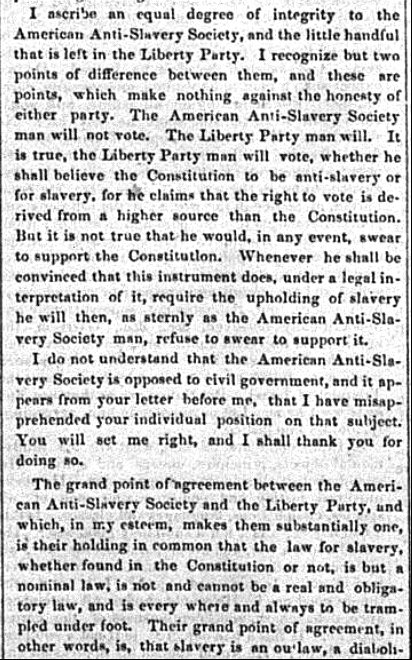
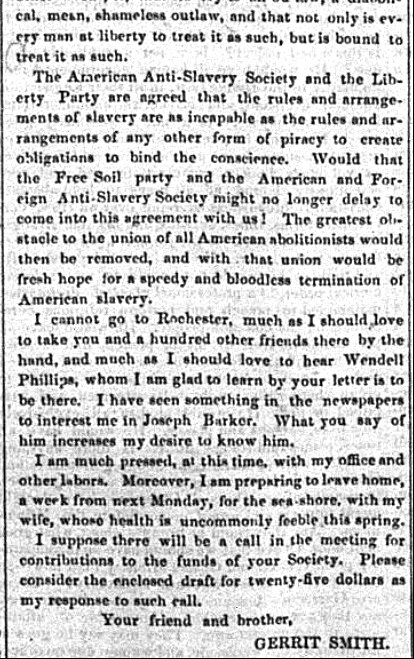
A much more readable account appeared in Frederick Douglass' Paper on May 20, 1852. Douglass expresses pride in the meeting being held in Rochester. The meeting wasn't allowed to be held in New York City because it was feared it would lead to trouble.
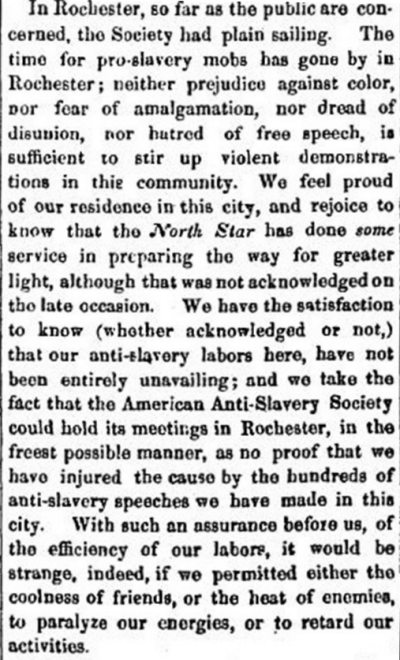
Douglass took the opportunity to answer the charges members of the American Anti-Slavery Society had made against him. Frederick did not feel the good will Gerrit Smith tried to create.
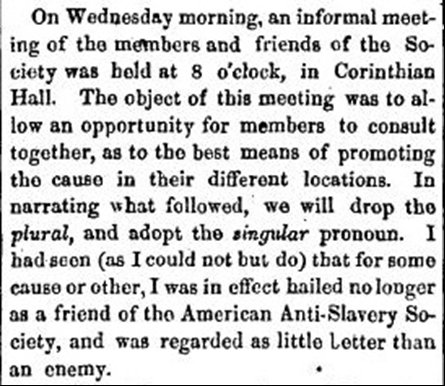
He accuses members of the Society of "seeking the destruction of the only paper in the United States conducted by a man of their own color". Douglass' defense occupies most of page 2. Page 3 has an article describing the Convention taken from the N.Y. Tribune. Douglass' article should be read for its insights into a dispute which was about to become both personal and bitter.
Douglass took the offensive, outraged the leaders of the American Anti-Slavery Society and they in turn attacked him. Things reached a low point when they appeared to attack Julia Griffiths in the November 18, 1853 Liberator.
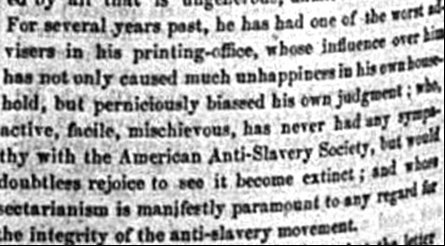
The "unhappiness in his own household" was answered by a letter from Anna Douglass which was printed in the December 2, 1853 Liberator. There was some discussion as to the origins of this letter.

This caused even more controversy. Frederick took the attack on his household personally and addressed the issue by devoting the first three pages of the December 9, 1853 Frederick Douglass' Paper to the issue. He reprinted articles from the Liberator, Anti-Slavery Standard, Pennsylvania Freeman and the Anti-Slavery Bugle and answered them in a nearly two page essay.
Regarding the "unhappiness in his own household" he stated.
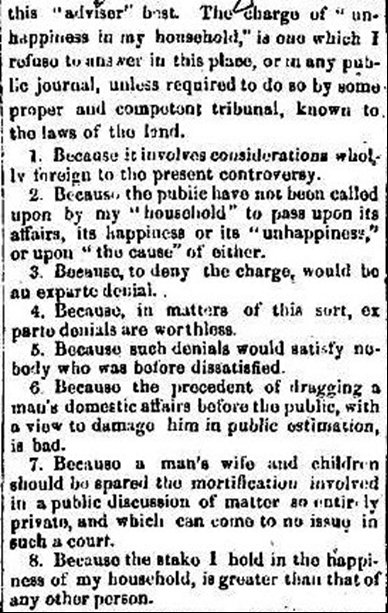
Douglass' attacks or rather the success of his attacks led to Garrison refusing to speak to him for many years. Douglass had gone from escaped slave, to antislavery agent, to newspaperman and with his break with Garrison would go on become the leading abolitionist of his day.
A University of Rochester student paper examines the friction between Douglass and Garrison.
Another on-line source is "The Lives of Frederick Douglass" which described the friction between Douglass and the New England abolitionists in its second half.
To get a glimpse of the situation and a look at the quality of Douglass' writing and thinking one should read portions of Frederick Douglass' Paper of May 20, 1852 or December 9, 1853. They are available on-line from the New York Public Library web site to holders of a NYPL card.
Back in the early 1850's some Rochesterians were concerned Douglass was being seen too often with Julia Griffiths. He addressed the issue in a January 12, 1851 letter to Samuel Porter. The letter was found in McKivigan, Frederick Douglass Papers: Series Three: Correspondence 1842 to 1852 Yale University Press.
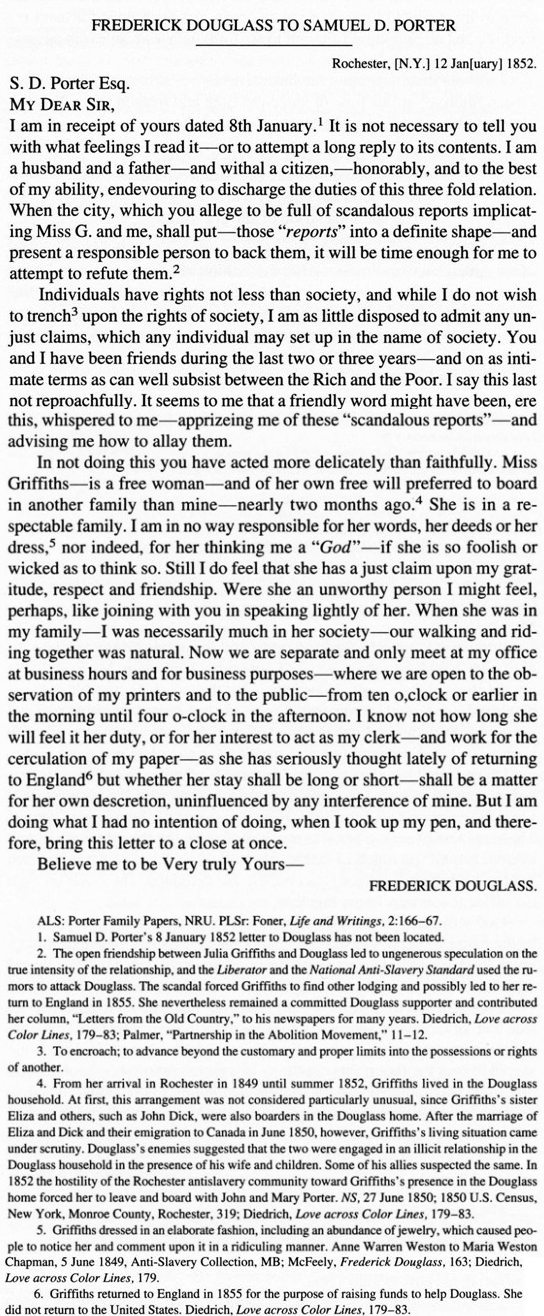
Note 4 is significant. Douglass' letter says Griffiths moved from the Douglass household in 1851. The footnote indicates the move occurred in 1852. Fought in Chapter 5 note 33 indicates the same. I would suggest a more mundane reason for moving than rumors which might arise from being seen together. The first being that in June 1850, Julia's sister married John Dick, the North Star printer, and the couple moved to Philadelphia and then Toronto. Most sources mention that during the 1850's Douglass typically spent 6 months on the road. The people Julia related to were no longer in the household so she might look elsewhere for lodging. If the move occurred in 1852, an additional reason would be the distance to the North Star office in the Talman building. The Alexander Street house was 0.8 miles from the office whereas the South Street property was 1.3 miles away. That area was also more isolated. I assume the winter months were the time Douglass was usually away and Julia would not look forward to the long walk to the Talman Building. Leigh Fought in Women in the World of Frederick Douglass, p. 135 states that Julia Griffiths moved in with Thomas and Marie Weddle. Their house was at the corner of Glasgow Street and Exchange, 0.6 miles for the North Star office. Thomas Weddle's business was located at the corner of Exchange Place and Front Street, literally just around the corner from the Talman building, so Julia would have someone to walk to work with. Marie Weddle was a member and officer of the Rochester Ladies Anti-Slavery Sewing Society.
1853 City Directory
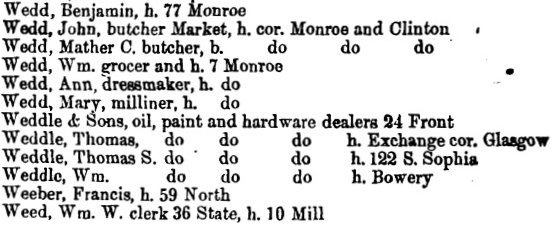
1855 City Directory
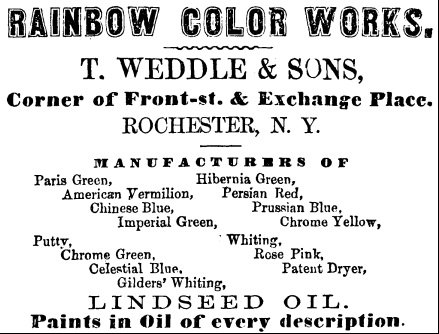
I was not able to find an original reference for the move to the Weddle's but the 1855 city directory shows Griffiths back at the Douglass'. The same directory shows the Weddles now living on North St. Paul Street.
1855 City Directory

1857 City Directory

Julia's return to the Douglass' coincides with the Weedles' move to North St. Paul and is consistent with Fought's information. Julia returned to England in June, 1855.
1855
While busy meeting attacks from the Garrisonians in 1854 Douglass remained politically active largely in the Liberty and Radical Abolitionist Parties. The Republican Party formed in 1854 but its platform of halting the spread of slavery and not its abolition kept Douglass away, although he endorsed its candidate John C. Fremont in the 1856 presidential election.
The first five minutes of a Khan Academy video outlines the early history of the Republican Party.
In the winter of 1855 Douglass delivered a speech, The Anti-Slavery Movement, on his tour. In Rochester it was delivered before the Rochester Ladies Anti-Slavery Society. He discussed the abolitionist movements four divisions, the Garrisonians, the Anti-Garrisonians, the Free Soil Party and the Liberty Party. He felt the movement had now entered the public consciousness in the North.
Three events in the 1850's brought this about. The Fugitive Slave Law of 1850, the Kansas-Nebraska Act of 1854 and the Dred Scott case of 1857. Douglass delivered speeches on all three. These events brought abolitionism from the radical fringe closer to mainstream thinking.
In August, 1855 he published his second autobiography, My Bondage and My Freedom. It sold 15,000 copies in two months. Many historians believe this is the Douglass autobiography to read. In the introduction to a 2014 edition published by Yale University Press, David Blight writes, " My Bondage and My Freedom (1855), crafted by a more mature writer in the midst of both a national and an individual crisis over the future of slavery and freedom, presented a text more personally revealing and more openly political than the earlier book".
Professor Blight's biography of Frederick Douglass will be published in October, 2018.
Capital Punishment
One of Rochester's most sensational murders took place on December 19, 1857. The perpetrator, Ira Stout, was hanged October 22, 1858. Frederick Douglass was drawn into events as an opponent of capital punishment.
From the Rochester Daily Democrat, October 6,1858, 2-5

From the Rochester Union and Advertiser, October 8, 1858 3-1:

A description of the meeting can be found at: http://frederickdouglass.infoset.io/islandora/object/islandora%3A1868#page/1/mode/1up.
Frederick Douglass' comments on the meeting were printed in the Rochester Union and Advertiser October 11, 1858 3-3:
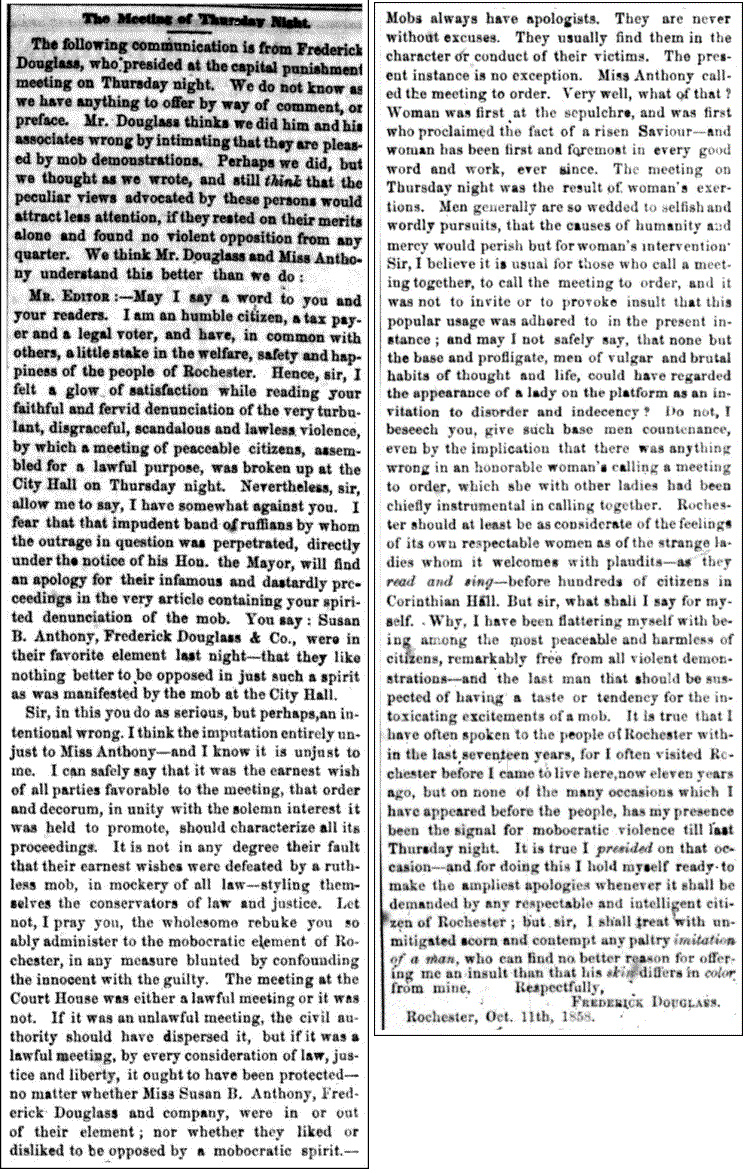
In the first week of August, 2018, a New York Times headline read, "Pope Francis Declared Death Penalty Unacceptable In All Cases." This statement was engulfed in controversy. Many of the issues of Douglass' time have not been resolved 150 tears later.
John Brown
In February, 1858 John Brown arrived in Rochester. In Life and Times chapter 10 Douglass wrote:
After the close of his Kansas work, Captain Brown came to my house in Rochester, and said he desired to stop with me several weeks; "but," he added , "I will not stay unless you will allow me to pay board." Knowing that he was no trifler and meant all he said, and desirous of retaining him under my roof, I charged three dollars a week. While here, he spent most of his time in correspondence. He wrote often to George L. Stearns of Boston, Gerrit Smith of Peterboro, N.Y., and many others, and received many letters in return. When he was not writing letters, he was writing and revising a constitution which he meant to put into operation by means of the men who should go with him into the mountains.
From the New York Times, February 25, 1895:
At his home on the little hill approaching what is now Highland Park, Frederick Douglass had many a distinguished visitor. Among them was John Brown, whose soul goes marching on." Here it was that "Old Ossaw"atime" unfolded the plan of the Harper's Ferry raid. Brown and Douglass took many a stroll over the neighboring Pinnacle Hills and discussed measures for the improvement of the condition of the negroes and ways of liberating them from bondage.
From the Rochester Union and Advertiser, April 9, 1859, 3:
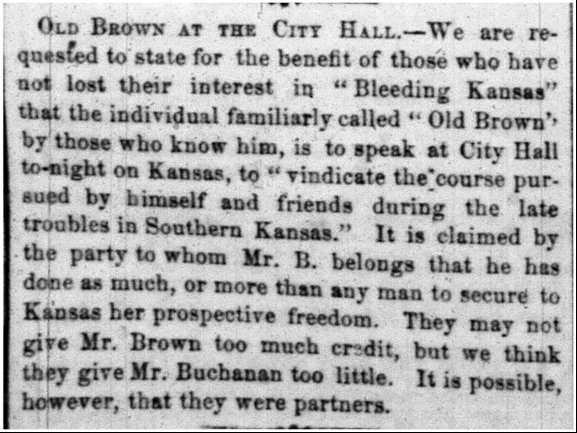
A web search will quickly provide information both on John Brown's raid on Harpers Ferry and the events which followed. In Life and Times, Chapter X, The Beginning of the End, Douglass discusses his relationship with John Brown and their meeting in Chambersburg, PA. A portion can be read here.
Articles on Wikipedia and smithsonian.com present material on Brown's life as well as the raid.
- https://en.wikipedia.org/wiki/John_Brown_(abolitionist)
- https://en.wikipedia.org/wiki/John_Brown%27s_raid_on_Harpers_Ferry
- https://www.smithsonianmag.com/history/john-browns-day-of-reckoning-139165084/
Between the middle of October and the middle of November, 1859 many articles appeared in Rochester newspapers discussing the raid.
From the Union and Advertiser, October 19, 1859, The Harper's Ferry Insurrection:

Who Is Brown, The Leader from the Rochester Daily Democrat, October 25, 1859:
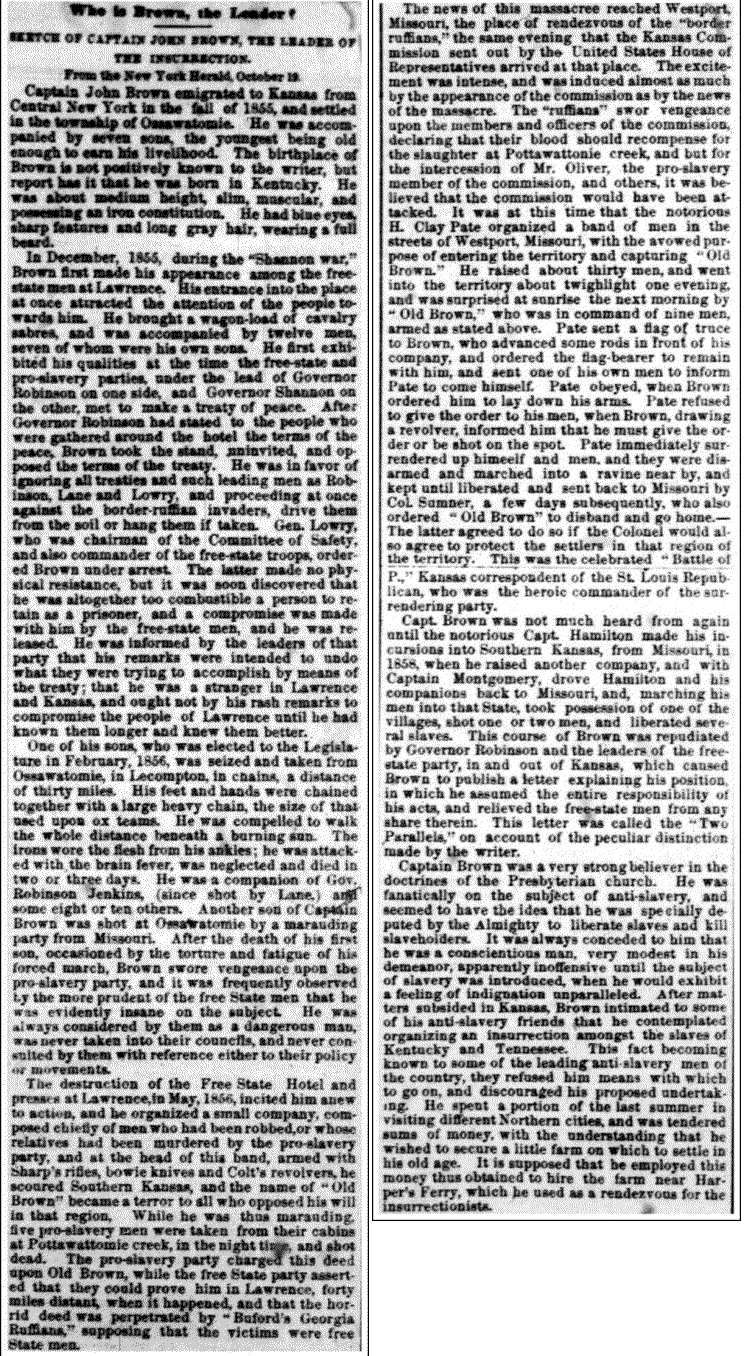
The Conviction Of Capt. Brown from the Union and Advertiser, November 2, 1859:
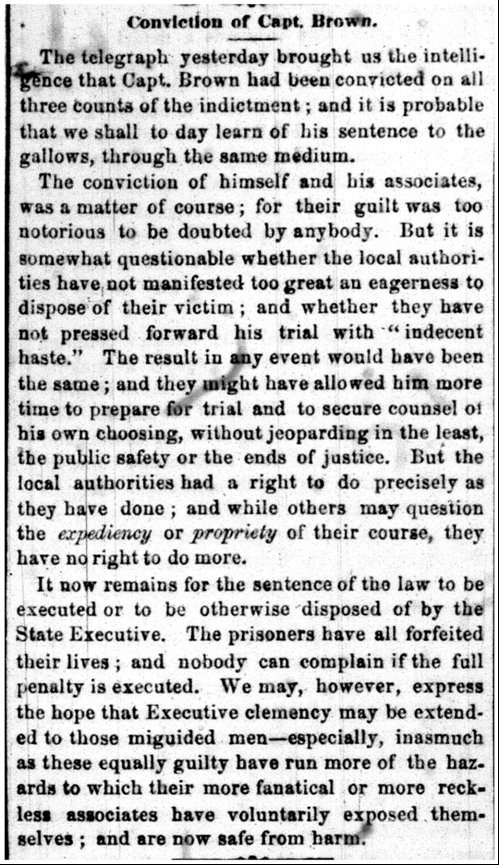
From the Union and Advertiser, December 1, 1859:
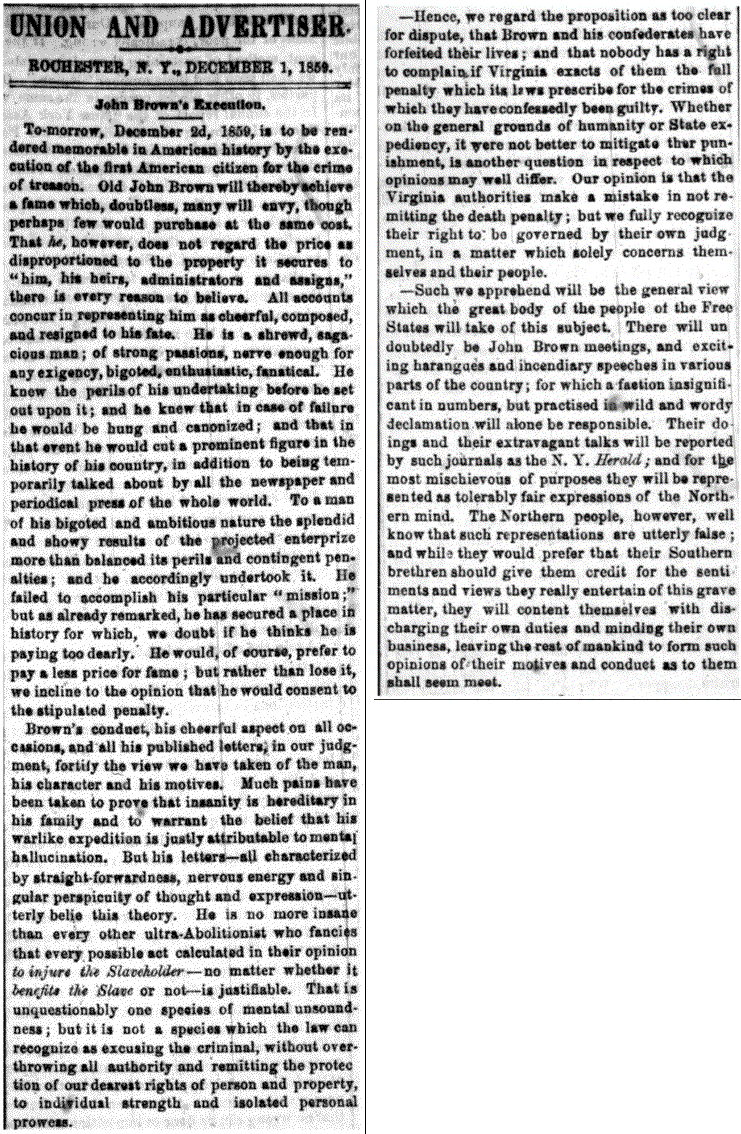
Again from the Union and Advertiser, A John Brown Meeting, November 26, 1859 and The Meeting At Corinthian Hall December 3, 1859:
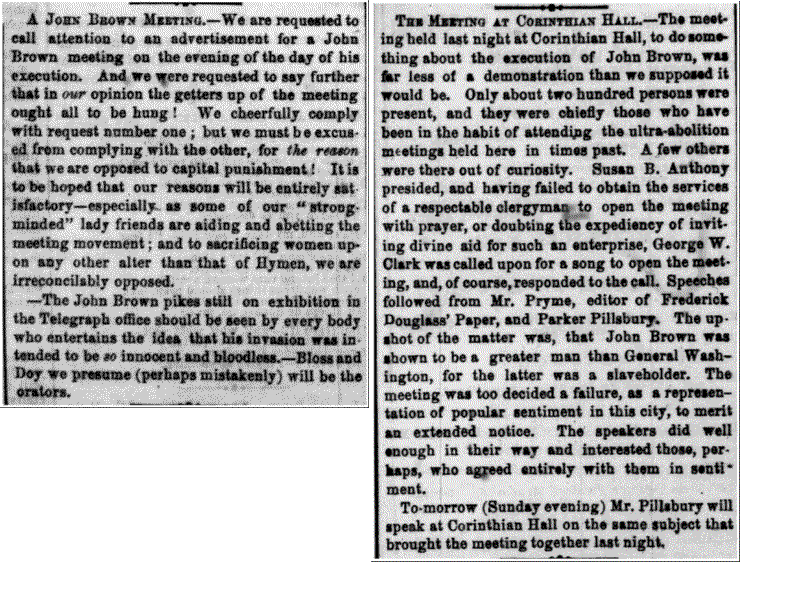
As now, political opinions of the time were sharply divided. The Rochester Republican and the Rochester Daily Democrat may have taken positions different than the Union and Advertiser.
In Chapter IX of Life and Times, Douglass describes the raid and his actions afterward. We know he went to Canada but he did not mention his route. McFeely on page 200 of his Douglass biography writes, "After dark on the day that Amy Post delivered the letter, she and Isaac had conducted Douglass to the wharf below the lower falls, near the mouth of the Genesee, to which he had taken so many runaways, and he was, himself, put on a boat for Canada." In a letter of October 27, 1859, written from Clifton, Canada and sent to Amy Post, Douglass writes, "Had I gone down to Rochester with our mutual friends, the other night, I should have walked into a trap." If Amy and Isaac had "conducted Douglass to the wharf below the lower falls" they would have known this and not need to be told in a letter.
The letter can be found at https://rbscp.lib.rochester.edu/4536#b as part of the University of Rochester Frederick Douglass Project.
In Life and Times Chapter IX Douglass also writes, "This plan was carried out, and I reached home in safety, but had been there but a few moments when I was called upon by Samuel D. Porter, Esq., and my neighbor, Lieutenant-Governor Selden, who informed me that the governor of the state would certainly surrender me on a proper requisition from the governor of Virginia and that while the people of Rochester would not permit me to be taken South, yet, in order to avoid collision with the government and consequent bloodshed, they advised me to quit the country, which I did - going to Canada."
A document written by family members of Lieutenant-Governor Selden in 1939 follows. It is based on the diaries and letters of Mr. Selden. I was unable to find these documents and would suggest a real historian look into the matter.
On the night of the 16th Frederick Douglas had been speaking in Philadelphia. Hearing of John Brown's successful raid he says, "I confess I was seized with a desire to reach a more northern latitude." Going at once to New York friends there took him to Patterson, N.J. where he left for Rochester on an Erie train. Meanwhile a U.S. Deputy Marshall from Virginia with a warrant for his arrest was traveling toward Rochester on a different route. On the train with the marshal was Henry R. Selden, who heard the officer bragging that he had come to arrest "a runaway nigger" for whom he held a warrant.
Mr. Selden was convinced that Douglas was the man wanted. Learning that the marshal proposed to refresh himself with supper at the Brackett House before proceeding on his mission, he hastened out South Ave accompanied by Mr. Samuel D. Porter. They reached the Douglas house a few minutes after its owner. In his autobiography "Life and Times", Douglas says, "My neighbor, Lieutenant Governor Selden and Mr. Samuel D. Porter called on me." The former warned him of the presence of the marshal, saying the Governor of New York State would be obliged to surrender him to the Governor of Virginia on proper requisition and that while the people of Rochester would not permit him to be taken south, in order to avoid collision with the Government and consequent bloodshed, he advised him to quit the country.
Acting on this advice Douglas rode a horse loaned by Mr. Selden, through Brighton and Irondequoit, to Charlotte. The circuitous route avoided Rochester and the two roads leading directly to the lake, on which pursuit might be expected. From Charlotte a sailing boat owned by a fisherman who was a link in the "Underground Railroad" carried him safely to Canada.
Family Sketches by Clara Sayre Selden
In collaboration
Elizabeth Selden Rogers
Henry Rogers Selden, II
George Baldwin Selden Jr.
1939
Page 17Note: In this text Douglass is spelled with one s.
You may have to be a resident of Rochester to know that the "wharf below the lower falls" mentioned by McFeely was not near the mouth of the Genesse but 4 1/2 miles away at the bottom of a nearly two hundreds foot deep gorge. The reason the landings were upriver is that downtown Rochester is about seven miles from Lake Ontario and at the time there was no way to move materials overland to the mouth of the river. There were three upriver landings in the vicinity of the lower falls, with King's Landing (1797) being first, Carthage Landing (1817) being second and Kelsey's Landing (1844) last. All required the extra task of moving material between the high banks and the river. This lasted until 1854 when a railroad was built to the mouth of the river and the village of Charlotte. With the completion of the railroad the upriver landings fell into disuse.
The following two advertisements from the Rochester Daily Union, May 31, 1855 show the lake boats now leave from Charlotte not Kelsey's Landing:
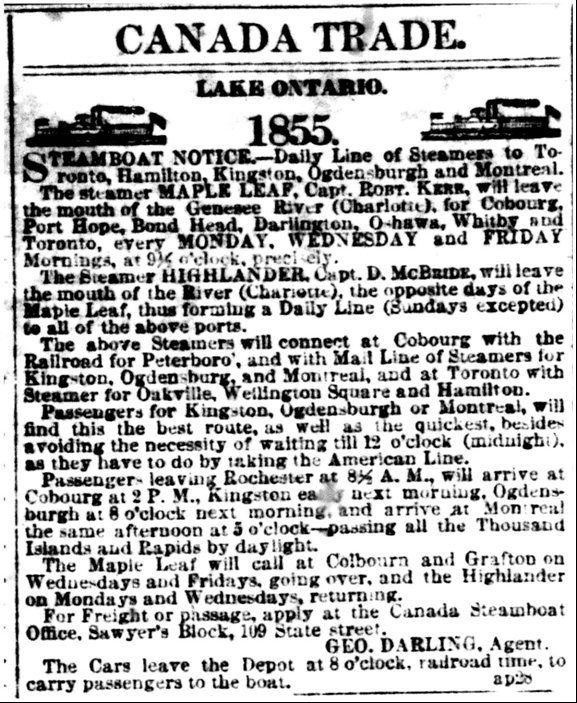
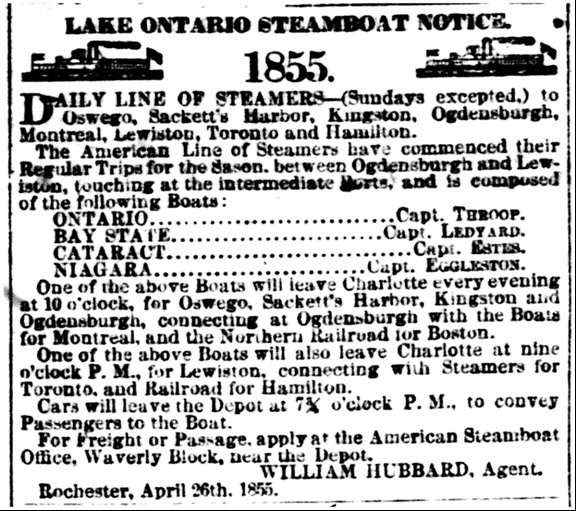
An 1859 ad no longer mentions Charlotte:
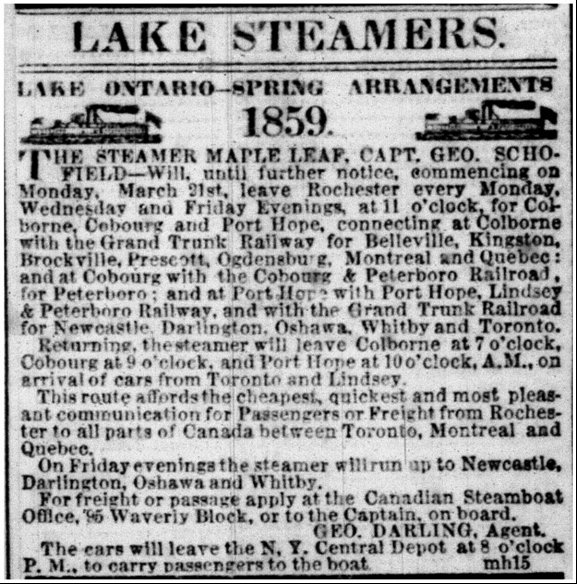
A few words about Ralph Francis are in order. The 1851 and 1853 City Directories show Ralph Francis a black man, as proprietor of the Steamboat Hotel at Kelsey's Landing. He was also a barber. By 1854 he has left Kelsey's Landing and relocated to Charlotte.

Buell Avenue, the road to Kelsey's Landing was unstable, very controversial and the subject of much local discussion. From the Rochester Daily Democrat, March 17, 1853.

From the Rochester Daily Democrat July 28, 1853
In Common Council, July 28, 1853
By Ald Chumasero - Resolved, That the Attorney take immediate measures for the discontinuance of Buell Avenue, as a public street or highway, from it's intersection with McCracken street, in the ninth ward of the city of Rochester to the Steamboat landing on the west side of the Genesee River.......
From the following ad, it appears Kelsey's Landing is being abandoned. A history of Buell Avenue and Kelsey's Landing has yet to be written. From the Rochester Daily Democrat, 1854.
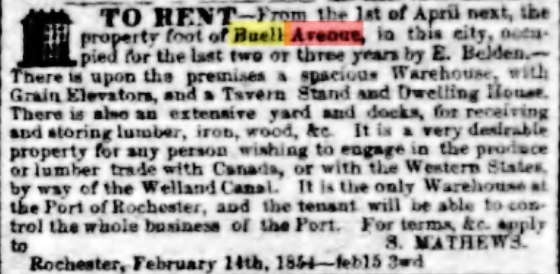
An article from the Rochester Daily Democrat June 14 1854 shows Ralph Francis has relocated to Charlotte.
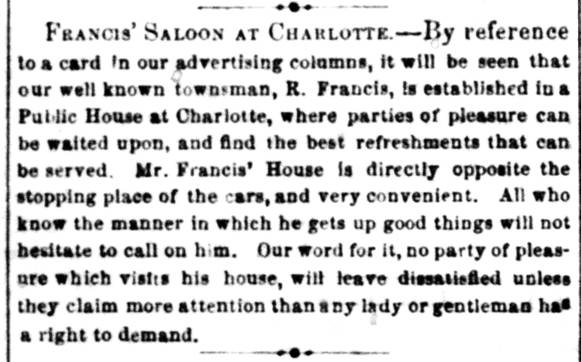
The advertising column from the same paper is included for local history purposes.
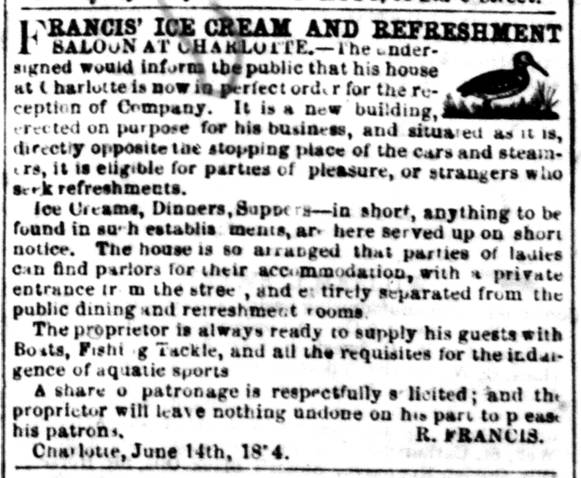
An October 27, 1859 letter Douglass sent to Amy Post came from Clinton, Canada. The letter can be found at https://rbscp.lib.rochester.edu/4536#b as part of the University of Rochester Frederick Douglass Project. Clifton is now part of Niagara Falls suggesting Douglass may have taken the train. The first train crossed the suspension bridge on March 18, 1855 and it became part of the Underground Railroad.
Crossing to Freedom: Harriet Tubman and John A. Roebling's Suspension Bridge
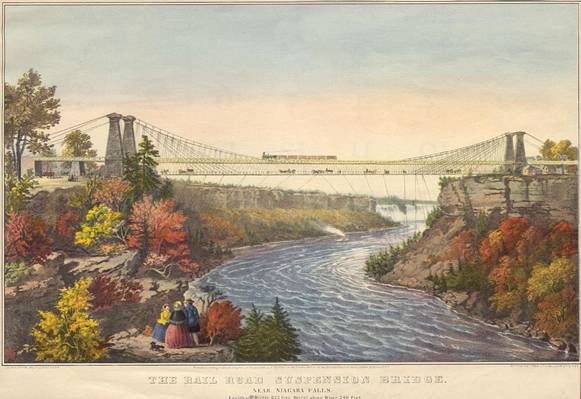
The 1855 and 1856 reports of the Rochester Ladies Anti-Slavery Society, found in the William E. Clements Library of the University of Michigan, indicate they helped 58 fugitive slaves in 1855 and 68 in 1866. The reports do not specify the type of aid rendered.
Two letters in the Clements library do shed some light. The first from the Syracuse Fugitive Aid Society dated November 29, 1856 says, "It has been our custom to forward all directly to the bridge. But now our friends fail us and we are obliged to send them forward to the different half way houses that are on their route." The letter is from W.E. Abbott to Maria G. Porter.
The second letter is from William J. Watkins to Mrs. Armstrong. The letter states, "I find, upon examination, that from Dec. 15th, 56 to August 9th, 57, I passed 59 fugitives to Canada as follows.
6 To Toronto and 53 to Suspension Bridge, St. Catharine's, Hamilton, etc," William J. Watkins was an associate editor of Frederick Douglass' Paper. From the 1855 City Directory.

This would suggest that once the Suspension Bridge opened to train traffic in 1855 it became the preferred route for escaped slaves going to Canada.
There is an 1895 remembrance of Douglass having taken the train to Canada. It is on page 21 of the Scrapbook linked to in the section on Douglass' Passing. It is from Ex-Deputy Secretary of State Col. Anson S. Wood of Wolcott.

The $200,000 is an error. Douglass likely went to Canada by train, not boat from Kelsey's Landing.
On November 4, 1859 The New York Daily Tribune published a letter which appeared in the Rochester Democrat.

The November 1859 issue of Frederick Douglass' Monthly contains, on page 162, a letter, TO MY AMERICAN READERS AND FRIENDS. Excerpts follow.
DEAR READERS AND FRIENDS:--- About to leave my post as Editor for a long contemplated visit and lecturing tour in Great Britain, which may detain me many months from my Editorial duties, the peculiar circumstances of the occasion seem to justify me in saying to you a few parting words...
It will probably be charged, by those who delight in aspersing me, that I go to England to escape the demands of justice for my alleged complicity with the Harper's Ferry Insurrection. I am not ashamed of endeavoring to escape from such justice as might be rationally be expected by a man of color at the hands of a slaveholding court, sitting in the State of Virginia. I am not a favorite in that state, and even if acquitted by the court, with my knowledge of slaveholding magnanimity and civilization, I could scarcely hope to cross the slaveholding border with my life...
For more than a year past I have been making arrangements not to go to Harper's Ferry but to England. This has been known alike to both friends and foes. My going too has been delayed, rather than hastened, by the occurrence of that outbreak.---The fact of my known intention to visit England in November, and my published lecturing engagements, in different parts of the State of New York, plainly show that no man had any right to expect my personnel co-operation elsewhere.
Douglass had scheduled a lecture tour delivering his speech, Self Made Men, in November. The tour was cancelled as he went to Canada.
In Boston he was replaced by Henry David Thoreau, who spoke on John Brown.

NY Daily Tribune November 4, 1859
Self-Made Men, which he began presenting on a tour of Illinois and Wisconsin in February of 1859, was Douglass' most requested speech. A condensed version of the speech delivered in Carlisle, Pennsylvania follows.
Self-Made Men: An Address Delivered In Carlisle, Pennsylvania IN March 1893
Self-made men are the men who, under peculiar difficulties and without the ordinary helps of favoring circumstances, have attained knowledge, usefulness, power and position and have learned from themselves the best uses to which life can be put in this world, and the exercises to which life can be put in this world, and in the exercises of these uses to build up worthy character.
The various conditions of men and the different uses they make of their powers and opportunities in life are full of puzzling contrasts and contradictions.
I do not think much of the accident or good luck theory of self-made men.
It is one of the easiest and commonest things in the world for a successful man to be followed in his career through life and to have constantly pointed out this or that particular stroke of good fortune which fixed his destiny and made him successful. If not ourselves great, we like to explain why others are so. We are stingy in our praise to merit but generous in our praise to chance.
Fortune may crowd a man’s life with favorable circumstances and happy opportunities, but they will, as all know, avail him nothing unless he makes a wise and vigorous use of them. Opportunity is important but exertion is indispensable.
It was once more common than it is now, to hear men religiously ascribing their good or ill fortune directly to supernatural intervention. Success and failure, wealth and poverty, intelligence and ignorance, liberty and slavery, happiness and misery, were all bestowed or inflicted upon individual men by a divine hand and for all-wise purposes. Man was, by such reasoners, made a very insignificant agent in his own affairs. It was all the Lord’s doings and marvelous to human eyes. Of course along with this superstition came the fortune teller, the pretender to divination and the miracle working priest who could save from famine by praying easier than by under-draining and deep plowing.
In such matters a wise man has little use for altar or oracle. He knows that the laws of God are perfect and unchangeable. He knows that health comes from right living: that disease is cured by the right use of remedies: that bread is produced by tilling the soil: that knowledge is obtained by study: that wealth is secured by saving and that battles are won by fighting. To him, the lazy man is the unlucky man and the man of luck is the man of work.
When we find a man who has ascended heights beyond ourselves: who has a broader range of vision than we and a sky with more stars than we have in ours, we may know that he has worked harder, better and more wisely than we. He was awake while we slept. He was busy while we were idle and he was wisely improving his time and talents while we were wasting ours.
From these remarks it will be evident that, allowing only ordinary ability and opportunity, we may explain success mainly by one word and that word is WORK! WORK!! WORK!!! WORK!!!!. Not transient and fitful effort, but patient, enduring, honest, unremitting and indefatigable work, into which the whole heart is put, and which, in both temporal and spiritual affairs is the true miracle worker. Everyone can may avail himself of this marvelous power if he will.
He who does not think himself worth saving from poverty and ignorance, by his own efforts, will hardly be thought worth the efforts of anybody else.
The lesson taught at this point by human experience is simply this, that the man who will get up will be helped up; and the man who will not get up will be allowed to stay down.
If the condensation seems harsh, the full speech can be read at http://monadnock.net/douglass/self-made-men.html.
Douglass sailed for England on November 12, returning to Rochester after learning of his daughter Annie's death on March 13, 1860.

NY Daily Tribune March 16, 1860
War Approaches
The section Irrepressible Conflict above contains information on the 1860 election.
In Douglass' Monthly, December 1860, Douglass wrote an article, "The Last Election".
Douglass acknowledges a change has taken place but does not see it as adequate. He writes,
If Mr. Lincoln were really an Abolition President, which he is not; if he were a friend to the Abolition movement, instead of being, as he is, its most powerful enemy, the dissolution of the Union might be the only effective mode of perpetuation slavery in the Southern States - since it could succeed, it would place slavery above the President and his Government. But the South has now no such cause for disunion. The present alarm and perturbation will cease; the Southern fire-eaters will be appeased and will retrace their steps. - There is no sufficient cause for the dissolution of the Union.
In an essay, "The Dissolution of the American Union", in Douglass' Monthly, January 1861, he doesn't seem to grasp the seriousness of the situation. He wrote,
The event so long and so loudly threatened by the state of South Carolina, and dreaded by the other States has at least happened, and is a matter of history. She has seceded, separated, repealed quitted the Union, declared her independence, set up for herself, assumed a place among the sisterhood of nations, pulled down the star spangled banner of the great American Confederacy, and upon innumerable pine poles have unfurled the Palmetto flag, preferring to be a large piece of nothing, to being any longer a small piece of something. Her ordinance of secession passed unanimously. Her people ( except those of them held in slavery, which are more than half her population) have hailed the event as another more glorious Fourth of July, and are celebrating it with plenty of gun powder, bad brandy, but not yet balls....
Douglass points out that South Carolina will need to do a more than make announcements, they will have to act.
In, The Union And How To Save It, from Douglass' Monthly, February 1861, he argues that the Union can only be saved by ending slavery and expressed disappointment with the actions of the North.
In viewing the alleged causes of the present perilous and dilapidated condition of the Federal Union, and the various plans by which it is proposed to set that Union in safety, all manly sensibility is shocked, and all human patience breaks down in disgust and indignation at the spectacle. The attitude of the Northern people in this crisis will crimson the cheeks of their children's children with shame. As between the North and the South, history will record the fact, that the latter, though engaged in a villainous and wicked cause, acted bravely, and displayed a manly spirit, while the former, with the best of causes, and pledged to it in open daylight before millions of their countrymen, acted the part of miserable cowards, insensible alike to the requirements of self-respect or duty.
Douglass delivered a speech with a similar title in Corinthian Hall in Rochester on March 25, 1862, "The War And How To End It".
I stand here to-night to advocate in my humble way, the unrestricted and complete Emancipation of every slave in the United States, whether claimed by loyal or disloyal masters. This is the lesson of the hour.
Abraham Lincoln delivered his inaugural address on March 4, 1861. There are many on-line sources.
Douglass report on Lincoln's Inaugural speech is in the April 1861, Douglass' Monthly. The report can be read on page 433 - 435 of the hathitrust.org web site. It is worth reading to appreciate Douglass' view.
The South shelled Fort Sumter on April 12 - 13, 1861. This is generally considered the start of the Civil War.
- https://en.wikipedia.org/wiki/Battle_of_Fort_Sumter
- https://www.smithsonianmag.com/history/fort-sumter-the-civil-war-begins-1018791/
Douglass' Monthly met the news head-on. The May issue had a graphic in the front page. It was a banner, an eagle and an American flag. Above it read "FREEDOM FOR ALL", and below in larger script, "OR CHAINS FOR ALL".
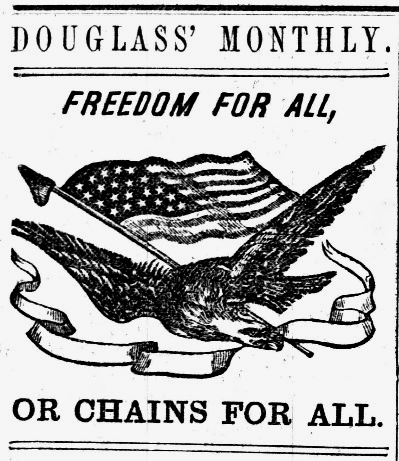
The paper contained two related articles. "THE FALL OF SUMTER" on page 450 and "HOW TO END THE WAR" on page 451.
In "THE FALL OF SUMTER" Douglass begins,
As a friend of freedom, earnestly laboring for the abolition of slavery, we have no tears to shed, no lamentations to make over the fall of Fort Sumter. By that event, one danger which threatened the cause of the American slave has been greatly diminished. Through many long and weary months, the American people have been on the mountain with the wily tempter, and have been liable at any moment of weakness to grant a new lease of life to slavery. The whole power of the Northern pro-slavery press, combined with the commercial and manufacturing interests of the country, has been earnestly endeavoring to purchase peace and prosperity for the North by granting the most demoralizing concessions to the insatiate Slave Power. This has been our greatest danger. The attack upon Fort Sumter bids fair to put an end to this cowardly, base and unprincipled trucking. To our thinking, the damage done to Fort Sumter is nothing in comparison with that done to the secession cause.
In "HOW TO END THE WAR" he writes,
To our mind, there is but one easy, short and effectual way to supress and put down the desolating war which the slaveholders and their rebel minions are now waging against the American Government and its loyal citizens. Fire must be met with fire, darkness with light, and war for the desecration of liberty must be met with the war for the destruction of slavery.
The simple way, then, to put an end to the savage and desolating war now waged by the slaveholders, is to strike down slavery itself, the primal cause o that war.
Lincoln's goal seemed to be to preserve the Union while Douglass' was abolition. They would remain at odds until the Emancipation Proclamation of 1863. In August of 1863 Douglass printed his Valedictory.
- https://en.wikipedia.org/wiki/Emancipation_Proclamation
- https://babel.hathitrust.org/cgi/pt?id=inu.30000007703097;view=1up;seq=364;size=150
In part Frederick wrote,
I will now tell affirmatively and directly why I lay down my pen and paper. The United States are now in the bitterest pangs of civil war. Slavery is the cause of this terrible war, and its abolition is decreed by one of the parties to the war. I am with the abolition party in war as in peace. I discontinue my paper, because I can better serve my poor bleeding country-men whose great opportunity has now come, by going South and summoning them to assert their just liberty, than I can do by staying here. I am going South to assist Adjutant General Thomas, in the organization of colored troops, who shall win for the millions in bondage the inestimable blessings of liberty and country.
The Maple Leaf
One book read during a class on slavery at RIT was A Voice of Thunder. Its subject was the Civil War letters sent by the black journalist George E. Stephens from the front to the New York Weekly Anglo-African newspaper. In order to report from the front he became a servant for an officer in the Army of the Potomac. After the Emancipation Proclamation was announced and the 54th Massachusetts Voluntary Infantry formed, he enlisted as a sergeant.
- https://en.wikipedia.org/wiki/54th_Massachusetts_Infantry_Regiment
- https://en.wikipedia.org/wiki/George_E._Stephens
One letter mentioned the 54th being transported along the Florida coast in a boat named the Maple Leaf. The Maple Leaf seemed like more of a northeastern name and a boat of that name sailed Lake Ontario. A look through the Rochester History index led to THE PORT OF ROCHESTER A History of Its Lake Trade by Blake McKelvey.
The following is copied directly from that issue.
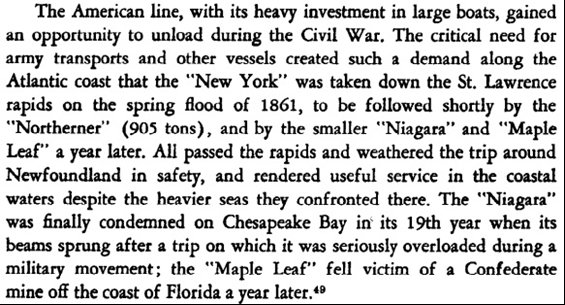
The remains of the Maple Leaf were found in 1984 and some artifacts are in a museum in Jacksonville, Florida.
A more complete story of the Maple Leaf is available.
Originally a Canadian boat, the Maple Leaf, was sold to an American company and from 1855 to 1862 docked at Charlotte. During this period the photographer E.T. Whitney made an ambrotype of the Charlotte harbor then known as the Port of the Genesee. A woodcut engraving appeared in Frank Leslies Illustrated newspaper.
- https://en.wikipedia.org/wiki/Photographers_of_the_American_Civil_War#E._T._Whitney
- http://images.maritimehistoryofthegreatlakes.ca/183/data?n=1
- https://en.wikipedia.org/wiki/Ambrotype


The Maple Leaf is in the right center, followed by the Highlander and the Ontario.
A Few Words About Money
Douglass' newspapers always had financial difficulties, to the point of his mortgaging his house to help support the North Star. When Julia Griffiths came to Rochester to visit, and then stayed for a period as business manager, she brought financial experience, having worked in her father's business. She and her sister Eliza taught Frederick the importance of separating personal and business monies. Frederick was intelligent, observant and a quick learner. He traveled in the circles of educated successful men, both black and white, from whom by direct conversation or observation he would receive a financial education.
An article in the Rochester Daily Union and Advertiser, September 8, 1866 3-3 suggests a candidate for Congress should step aside and be replaced by Frederick Douglass. One reason was that Douglass paid income tax and the candidate did not. Further he paid on an income of $5175. At that time an unskilled laborer earned about $500 per year and a skilled craftsman $900.
The tax referred to is the Civil War Income Tax which was instituted to pay for the Civil War. The bill was passed in late 1861 and repealed in 1871.
The National Archive website indicated they had the material and a brief contact indicated the material was on-line at ancestery.com. A stop at the Federal Building in New York turned up two records, for 1865 and 1866.
1865
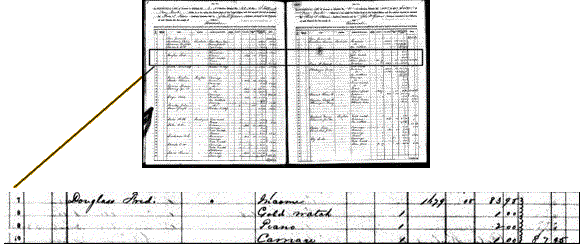
Douglass paid $83.95 tax on an income $1629 and $1 for a gold watch, $1 for a piano and $2 for a carriage for a total tax of $87.95
1866
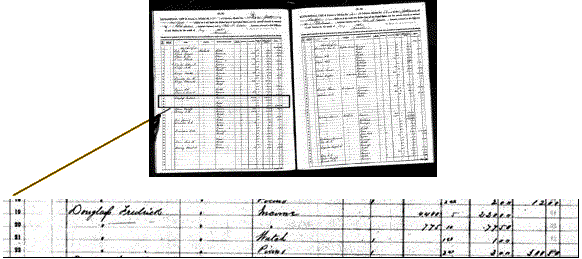
In 1866 Douglass paid $220 on income of $4400 taxed at a 5% rate and $77.50 on income of $775 taxed at a 10% rate. He also paid $1 for a watch and $2 for a piano. The total was $302.50.
A second contact indicated these are the only records available.
Another look at Douglass' wealth came in June 1872 when his house burned. In an article in the Union and Advertiser, June 17, 1872 2-2 he states, "Eleven thousand dollars worth of government securities (which I have fortunately the numbers) were destroyed."
In his book "Giants" , John Stauffer points out that Douglass was a very in demand orator with correspondingly high fees. In 1859 Douglass' speaking fee was $25. By 1875 his fee had risen to $100 per speech.

Frederick Douglass Papers at the Library of Congress
The final citation in this brief look is a New York Times article from March 7, 1895 titled DOUGLASS'S WILL TO BE CONTESTED. The line of interest is, "Two years ago the estate was valued at $200,000." An on-line inflation calculator points out, $200,000 in 1895 is the equivalent purchasing power to $5,836,190.48 in 2017. Douglass applied himself and fulfilled his own definition of a self made man, which was the title of his most popular speech.
Fire
With the onset of the Civil War Douglass focused on the big picture and became more involved nationally and less locally. This may have come more pronounced when he discontinued his newspaper and focused on recruiting black troops for the Union Army. After the war he spent time in Washington, DC and bought a house there on June 22, 1871. The deed is in the Frederick Douglass Papers at the Library of Congress. I have not researched the deed.
Douglass' house located south of Rochester burned in June of 1872.
The story is told in the Union and Advertiser, June 3, 1872,

Douglass has his say in the Union and Advertiser of June 17, 1872.
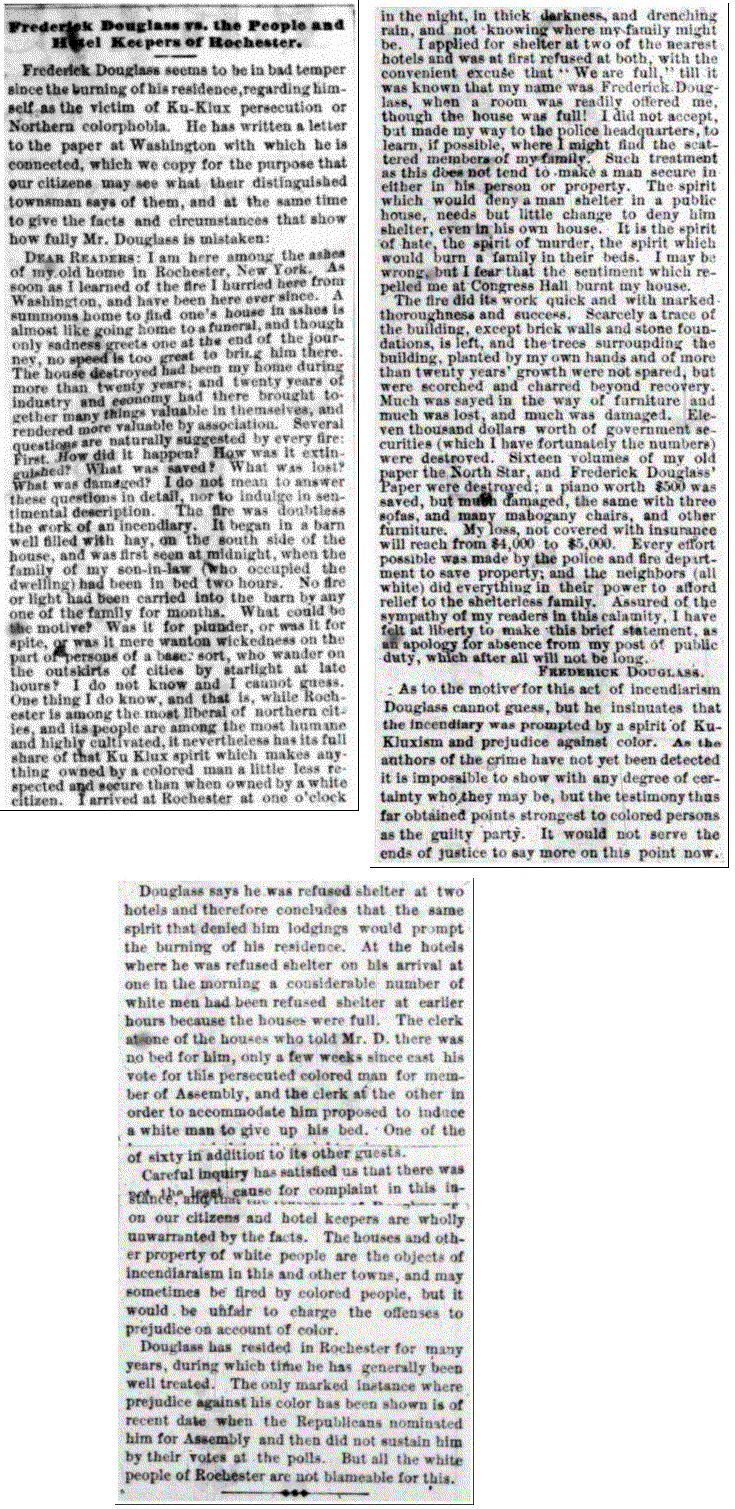
After the fire Douglass moved his family to Washington, DC.
Soldier and Sailors Monument
While Douglass left Rochester for Washington in 1872 he did return to visit the area. On two of these visits in 1874 and 1882 he was photographed by John Howe Kent whose studio was at different times located at 58, 30 and 24 State Street.
The most significant of Douglass' visits was for the dedication of Rochester's Civil War monument, the Soldiers and Sailors Monument, in Washington Square Park on May 30, 1892. From a local history perspective the most significant event on that occasion was referred to in the Union and Advertiser of that date as BREAKFAST AT CHARLOTTE.
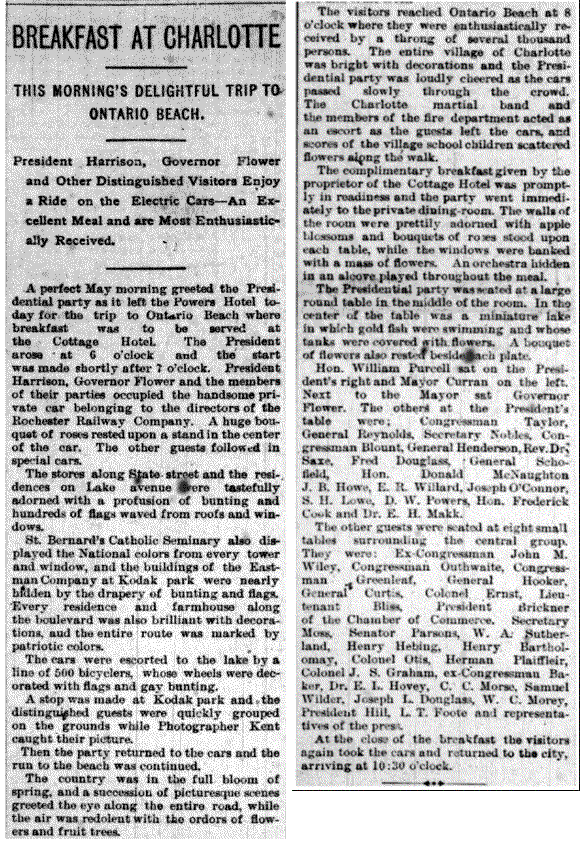
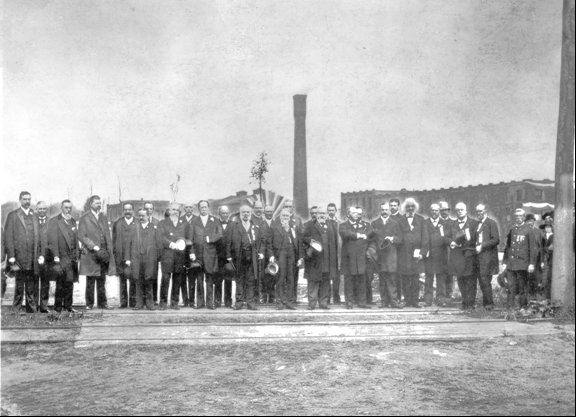
George Eastman Museum
The photograph was taken by John Howe Kent. Douglass is in the right quarter of the picture. Lore has it that this was the first occasion where the name Kodak Park was used officially. This was the name the Kodak facility would carry for 100 years.
Passing
Frederick Douglass passed away on February 20, 1895 at the age of 77. A memorial service was held in the Metropolitan African Methodist Episcopal Church in Washington after which the body, accompanied by family members, was put on a train to Rochester scheduled to arrive at 9:25 in the morning. According to a New York Times article of February 27, 1895,
Great crowds thronged Central Avenue, Clinton, East Main, and Fitzhugh Streets, through which the procession passed, and thousands followed to City Hall....
The hall was draped with black bunting and national flags. For more than three hours there was an unbroken procession of white and black citizens, men and women, passing by the casket to take a last look at the features of the honored dead...,
The body was taken at 1:30 o'clock to Central Church, (Presbyterian,) the largest and one of the most handsome in the city....
Every seat in the church was occupied and the aisles were crowded....
At the close of the exercises the body was taken to Mount Hope Cemetery, to be buried beside the grave of Frederick Douglass's first wife.
In 1897, Douglass' second wife, Helen Pitts, edited a book In Memoriam: Frederick Douglass which contained details of both ceremonies as well as public and private tributes. The book is downloadable from the Monroe County Library web site. The library also has a scrapbook containing newspaper articles from that time.
Two surprises.
Anna Murray passed away on August 4, 1882 and was buried in Graceland Cemetery in Washington.
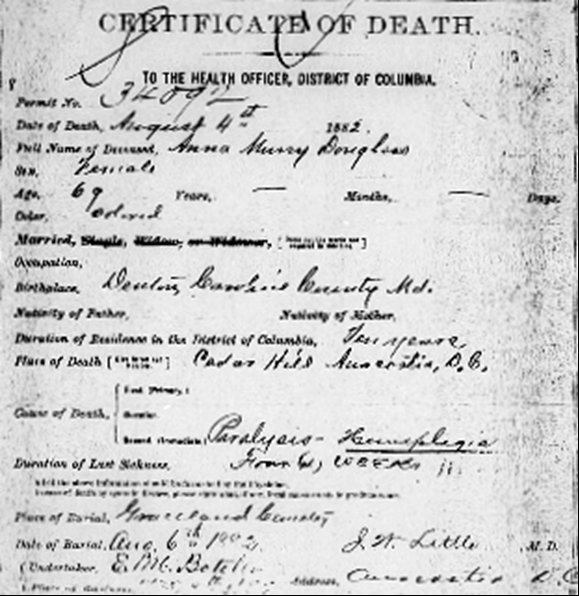
A New York Times article of October 1, 1898 was titled, DOUGLASS'S SON PROTESTS - Proposed Removal of the Negro Leader's Remains to Anacostia, D.C. This appears to be part of a plan by Helen Pitts, Douglass' second wife, to establish the Douglass Washington home, Cedar Hill, as a Douglass memorial.
It reads in part,
This bill is a direct insult and affront to every member of our family. In order to make the whole conception of a memorial to Frederick Douglass still more attractive, it is proposed that the body be brought here. Section D of the bill provides that the body of my father may be removed from Mount Hope Cemetery, where it now rests, taken away from the side of my mother, who was his companion and helpmeet for well-nigh half a century....
Indeed, my father had often expressed the wish that he be buried at beautiful Mount Hope Cemetery, at Rochester, for it is there that much of his great anti-slavery work was accomplished, and it is there that we, his children were born.
The person quoted is Charles R. Douglass.
The Douglass Mt. Hope Plot
When Douglass was in England, after John Brown's Raid, his 10 year old daughter Annie passed away. The Douglass family did not have a burial plot so she was laid to rest in the plot of family friend Samuel D. Porter. When Douglass returned from England he purchased a family plot in Mt. Hope Cemetery and Annie was moved there.
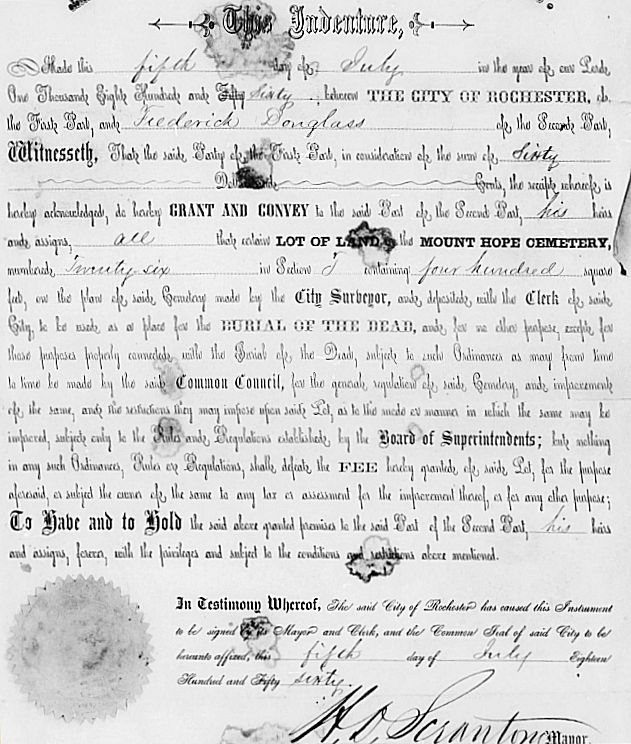
When his first wife Anna passed in 1882, the family was living in Washington so she was buried in Graceland Cemetery, likely to be closer to the family. When Frederick died in 1895 he was buried in Mt. Hope Cemetery and on March 19, 1898 Anna was placed on his left. The stone to the rear of Frederick's grave is dedicated to the memory of Anna and Annie as well as Frederick.
His second wife, Helen Pitts, passed away on December 1, 1903 and was buried on his right. Her grave had no marker until 1972 when the Frederick Douglass Memorial and Historical Association placed a marble slab on her burial site.
Epilogue Afterlife 1895 - 1903 in Leigh Fought's book, Women in the World of Frederick Douglass, has information on Douglass' family during this period.
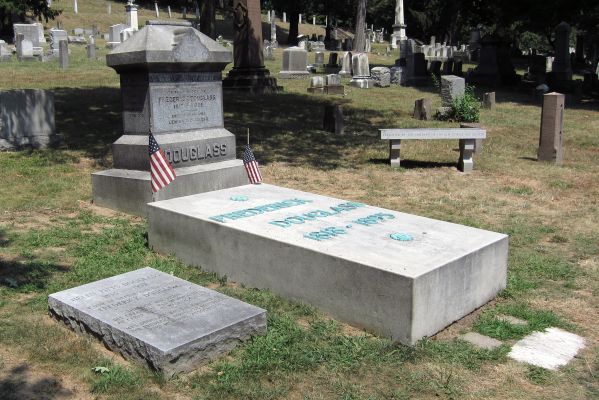
Douglass Plot - 2014
The monument behind Douglass reads
FREDERICK DOUGLASS
1817 - 1895
_______________________
ERECTED BY HIS SONS
LEWIS H. & CHARLES R.
When Douglass passed it was believed he was born in 1817. Information uncovered since then led to his birth year being changed to 1818.
On the left side
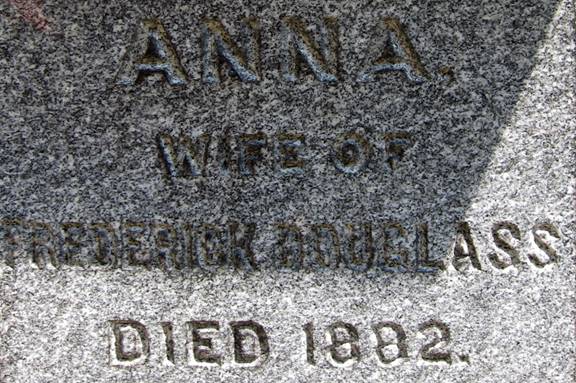
On the right

Helen Pitts Douglass' marker
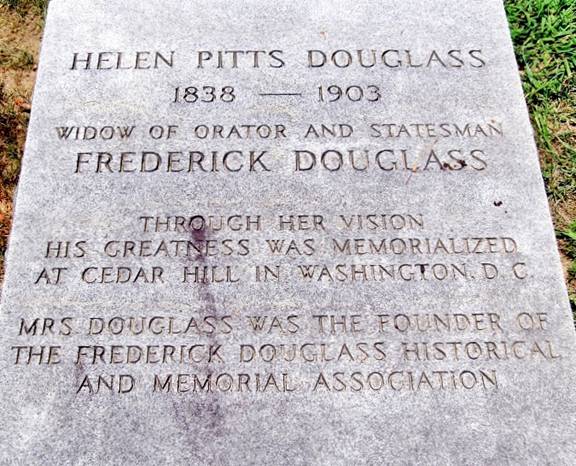
Frederick Douglass
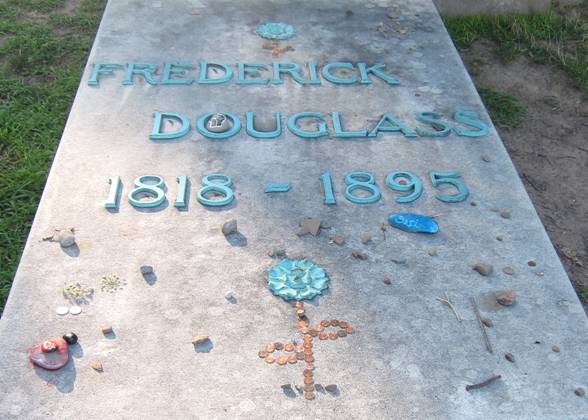
Douglass Monument
Retrofitting Rochester - Frederick Douglass MonumentWhen the Soldiers and Sailors Memorial was dedicated it was noted no black soldiers were represented. A movement was started with the aim of erecting a monument to black Civil War soldiers. Frederick Douglass died shortly after the plan was put into action and its goal was changed to building a monument to Douglass. The driving force was John W. Thompson. In 1903 he wrote an authentic history of the Douglass monument. A report on the monument is courtesy of Andrew J. Williams, II.
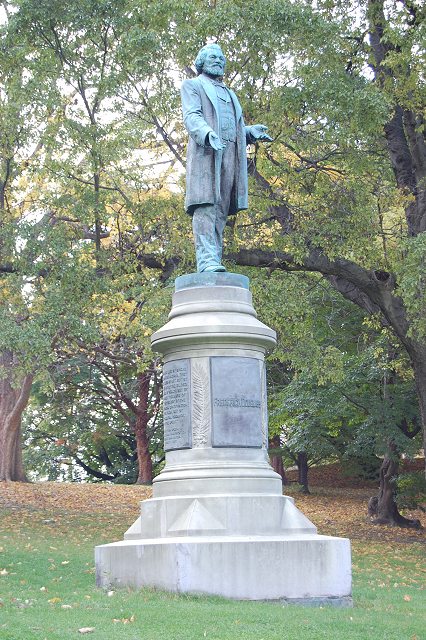
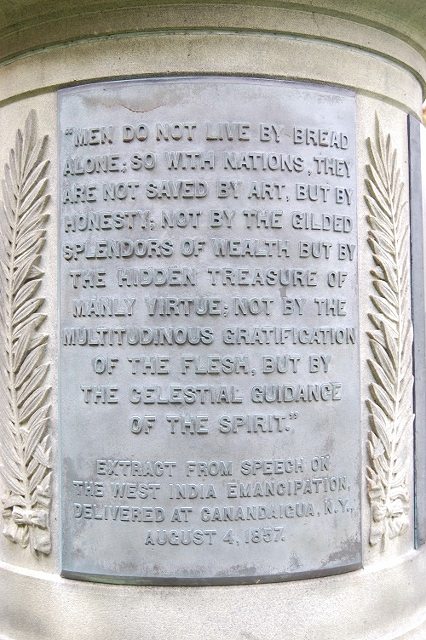
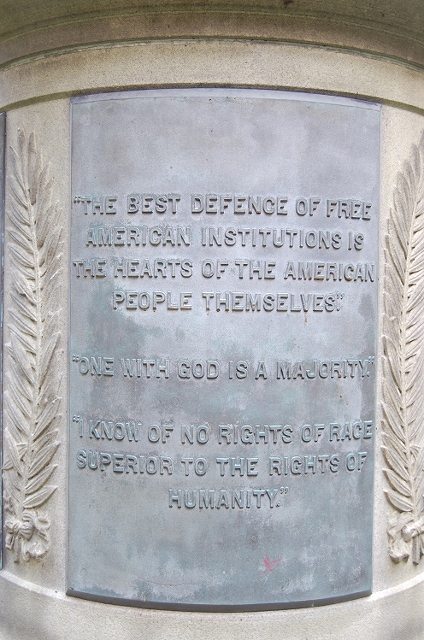
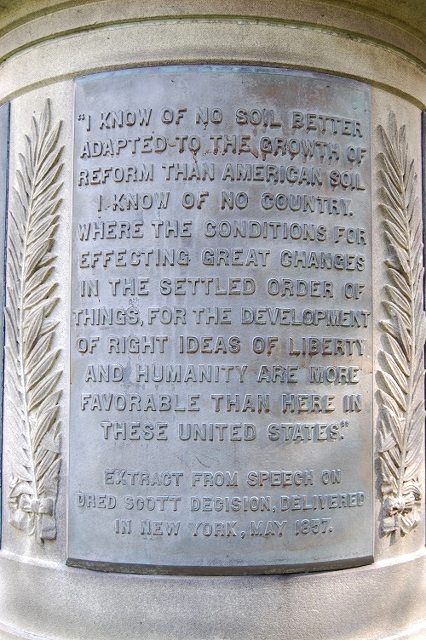
To improve access and visibility, in late October 2019, the Douglass Monument was moved a short distance to a new plaza on the southwest corner of South Avenue and Robinson Drive.
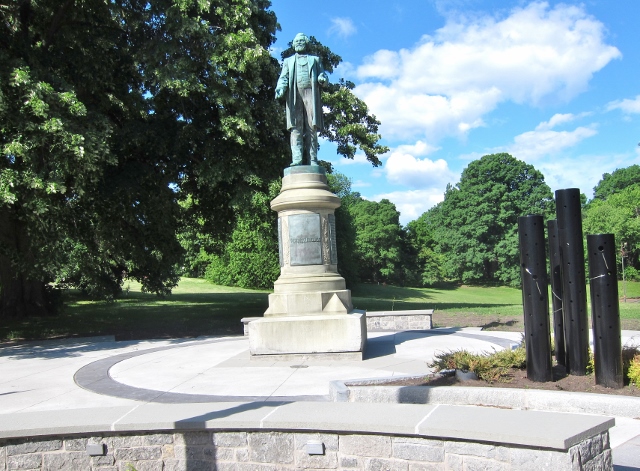
Douglass Monument Replicas
In 2018, as part of the Douglass Bicentennial, the sculptor Olivia Kim, made fiberglass replicas of the Douglass statue, which were placed at 13 locations around Rochester.
